19% Faster in Battlefield 4
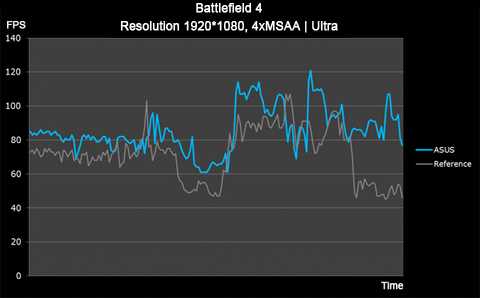
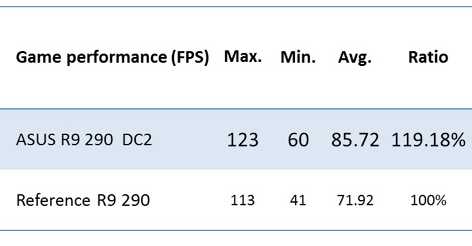
Ultimate Cooling
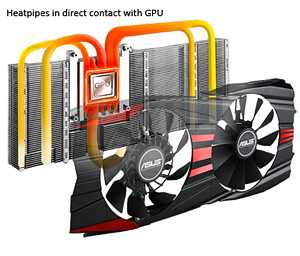
DirectCU II
20% Cooler and 3X* Quieter
For Ultimate cooling, ASUS thermal engineers developed the exclusive DirectCU thermal technology. Applying the exclusively designed heatpipes directly on GPU core for faster heat dissipation. Exclusive DirectCU II thermal design includes a direct-GPU contact 10mm copper heatpipe and 220% larger dissipation area to boost heat removal efficiency. It performs 20% cooler and 3X quieter than reference.
*Equivalent to 14dB and performance varies depending on system configuration
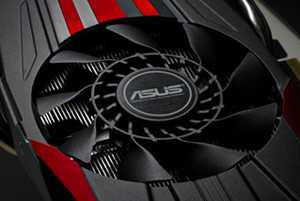
CoolTech Fan
Proprietary CoolTech fan consists of a hybrid blade and bearing design, with inner radial blower and outer flower-type blades. These provide multi-directional airflow to accelerate heat removal and enable highly stable graphics performance.
Ultimate Stability
DIGI+ VRM with Super Alloy Power
30% Less Power Noise and 2.5X Greater Durability
Acclaimed DIGI+ VRM has been applied via a 8-phase power design that uses digital voltage regulators to minimize power noise by 30%, enhance power efficiency by 15%, widen voltage modulation tolerance, and improve overall stability and longevity by 2.5 times over reference.
POSCAPs to lower power noise, enhance overclocking, and improve stability far beyond standard analog designs.
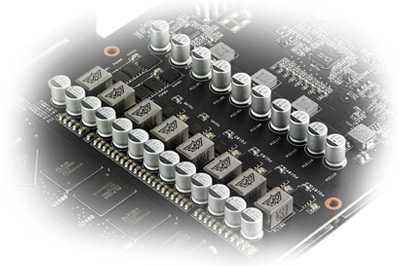
Ultimate Graphics Tuning
GPU Tweak
Real-Time Intuitive Graphics Tuning
- Shows detailed specs and actual card status with GPU-Z
- Sync GPU clocks and voltages for easier overclocking
- Monitoring widget provides real-time detailed multi-parameter info
- 2D/3D switcher locks cards in 3D mode for higher benchmarks
- Automatically checks and updates drivers and BIOS versions
- Stream on-screen action to the web in full HD
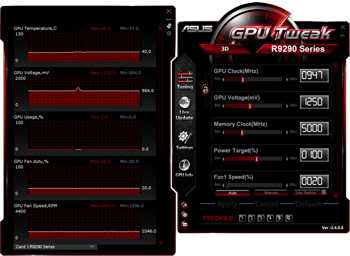
Stream Online Instantly
GPU Tweak streaming tool that lets you share on-screen action in real time – so others can watch live as games are played. It’s even possible to add to the streaming window scrolling text, pictures and webcam images.
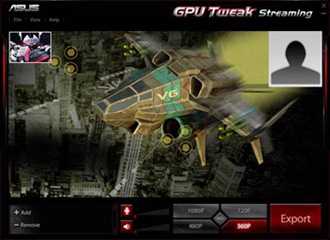
Graphics GPU Features
Powered by AMD Radeon R9 290
AMD EyefinityTechnology
Extend the view across up to six displays to immerse yourself in gameplay and entertainment.
CrossFire Support
Multi-GPU technology for extreme performance.
AMD HD3D
Immerse in stereoscopic 3D gaming and get up close and personal with your favorite stars while watching Blu-ray 3D. AMD HD3D is also designed for professionals who create complex visual effects and detailed data visualizations.
PCI Express 3.0
Delivers double the bandwidth per lane of PCIe 2.0 for faster GPU-CPU communication.
Microsoft DirectX 11.2
Brings new levels of visual realism to gaming on the PC and get top-notch performance.
Specifications
| Graphics Engine | AMD Radeon R9 290 |
| Bus Standard | PCI Express 3.0 |
| Video Memory | GDDR5 4GB |
| Engine Clock | 1000MHz |
| Memory Clock | 5040MHz (1260MHz GDDR5) |
| Memory Interface | 512-bit |
| Interface | DVI Output: Yes x 2 (DVI-D) HDMI Output: Yes x 1 Display Port: Yes x 1 (Regular DP) HDCP Support: Yes |
| Power Consumption | Up to 300W additional 6 + 8-pin PCIe power required |
| Accessories | 1 x Power cable |
| Software | ASUS GPU Tweak & Driver |
| ASUS Features | DirectCU Series OC Series Super Alloy Power |
| Dimensions | 11.3 x 5.8 x 1.6-Inch |
| Note |
|
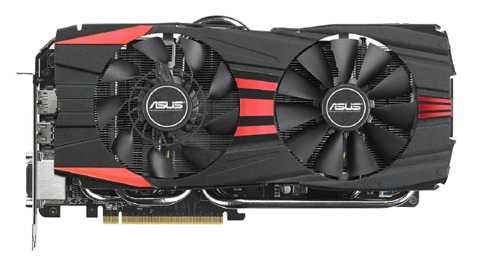
Cooling System: Efficiency and Noise Level
The DirectCU II cooler claims to be 20% more efficient and 3 times quieter than AMD’s reference solution. It really seems to be capable of that, featuring a large aluminum heatsink with heat pipes and two fans covered with a metal casing.
There are as many as five nickel-plated copper pipes here, two of which are 6 mm in diameter. Two more pipes are 8 mm and there’s also a 10mm pipe there.
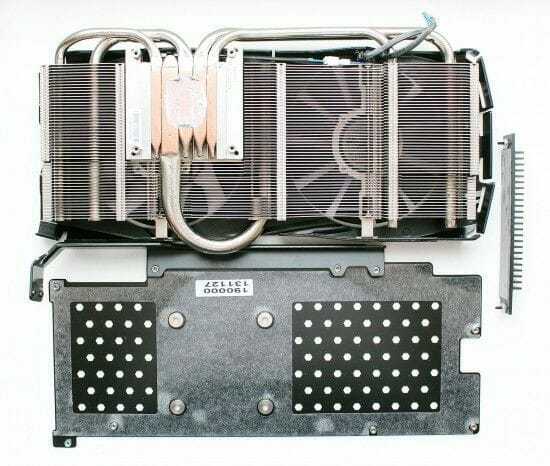
The heatsink features direct-touch technology meaning that the heat pipes have direct contact with the GPU.
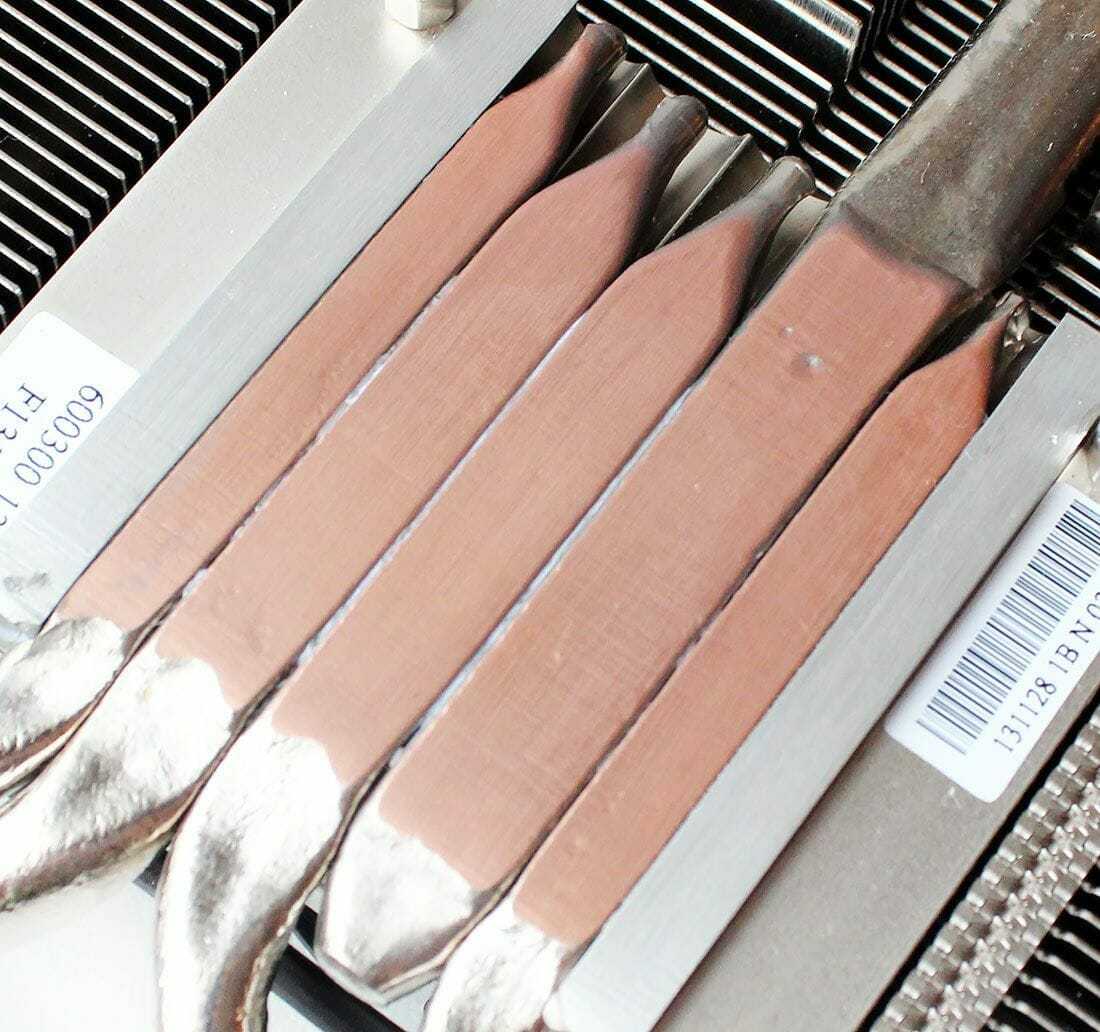
The thermal grease imprint indicates that the GPU only contacts with the two 8mm pipes and with one half of the 10mm pipe. The outermost 6mm pipes transfer heat from the sides of the adjacent pipes only, which is hardly an efficient solution. The pipes and heatsink fins are soldered to each other. The power components in the back part of the PCB are equipped with a small aluminum heatsink with a thermal pad. The solid-state capacitors (located near the video outputs) and the memory chips have no heatsinks and are cooled by the air flow from the fans.
The fans have identical motors but different impellers. They are both about 95 mm in diameter.
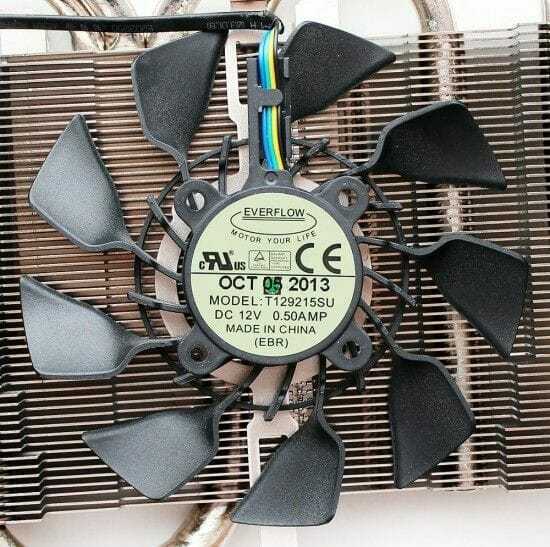
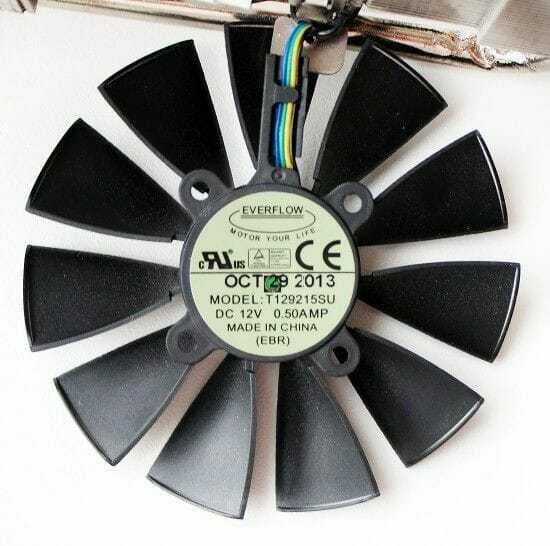
The fan above the GPU has a dual impeller with two sets of differently shaped blades. ASUS calls it CoolTech and showcases its benefits in the following demo:
The original fan is indeed more efficient than the ordinary one. The question is why didn’t ASUS install two such fans on the card? The fans are PWM-regulated in a range of 1000 to 3000 RPM.
To measure the temperature of the ASUS Radeon R9 290 DirectCU II graphics card we ran Aliens vs. Predator (2010) five times at the maximum visual quality settings, at a resolution of 2560×1440 pixels, with 16x anisotropic filtering and with 4x MSAA.

We used MSI Afterburner 3.0.0 beta 18 and GPU-Z version 0.7.7 to monitor temperatures inside the closed computer case. The computer’s configuration is detailed in the following section of our review. All tests were performed at 25°C room temperature.
With the fans regulated automatically, the GPU is 80°C hot while the fans rotate at 1800 RPM (47%).
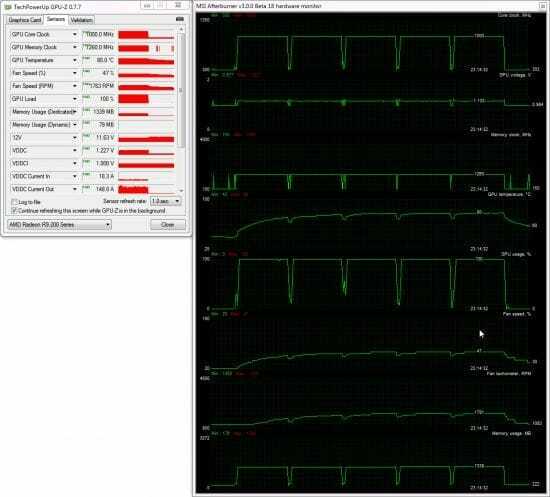
This is 14-15°C better than the result of the reference AMD Radeon R9 290 tested under the same conditions. Most importantly, the ASUS version doesn’t drop its GPU frequency in this test, so the DirectCU II copes with its job very well.
If the fans are manually set at their maximum 3000 RPM, the top GPU temperature is only 69°C.
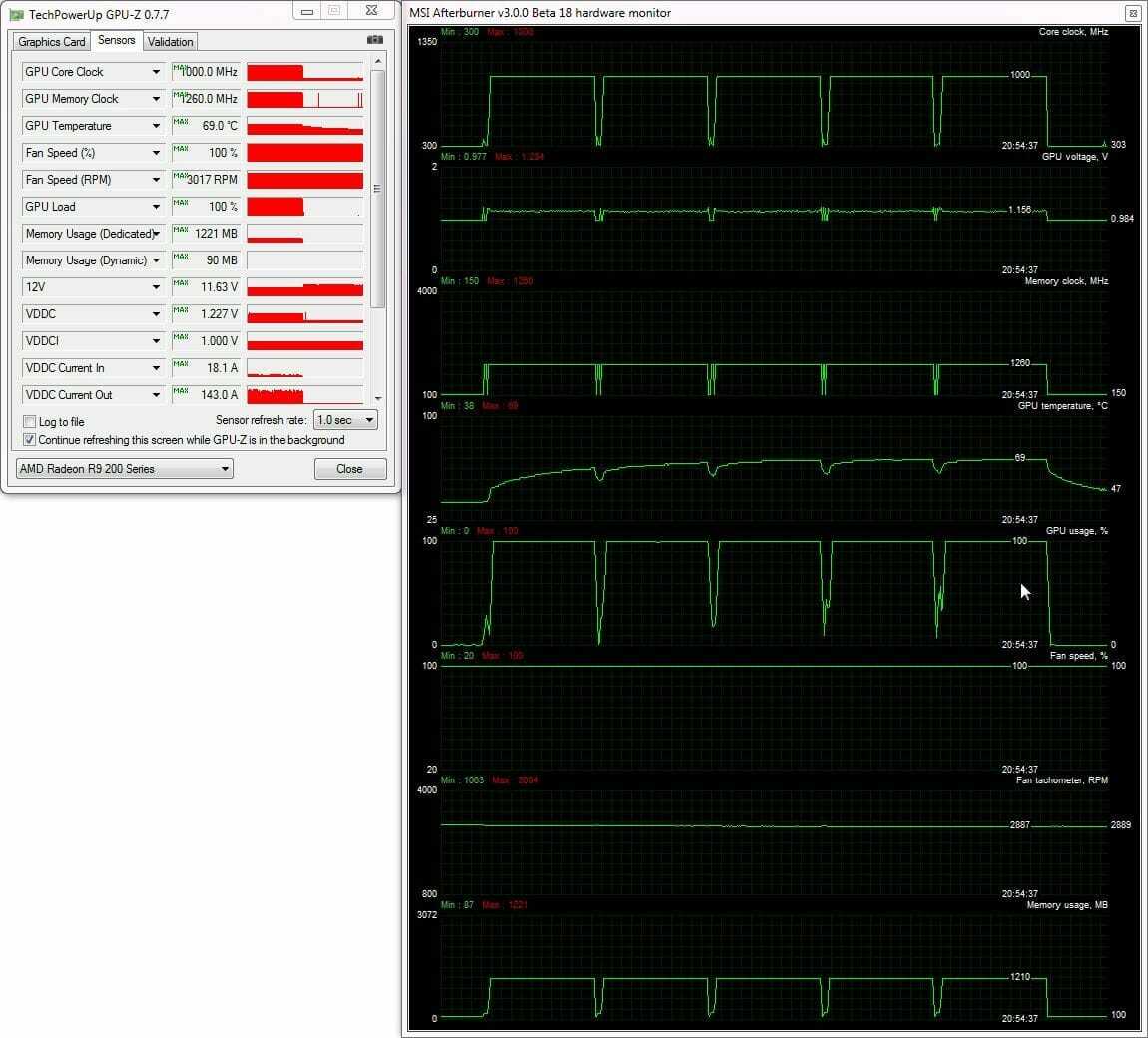
The graphics card becomes rather noisy at that, though.
We measured the level of noise using an electronic noise-level meter CENTER-321 in a closed and quiet room about 20 sq. meters large. The noise-level meter was set on a tripod at a distance of 15 centimeters from the graphics card which was installed on an open testbed. The mainboard with the graphics card was placed at an edge of a desk on a foam-rubber tray. The bottom limit of our noise-level meter is 29.8 dBA whereas the subjectively comfortable (not low, but comfortable) level of noise when measured from that distance is about 36 dBA. The speed of the graphics card’s fans was being adjusted by means of a controller that changed the supply voltage in steps of 0.5 V.
We’ll compare the noise level of the ASUS Radeon R9 290 DirectCU II with that of the reference R9 290 from AMD. We also include the results of the Nvidia GeForce GTX 780 Ti and the original MSI GeForce GTX 780 Ti Gaming for the sake of comparison. The vertical dotted lines mark the top speed of the fans in the automatic regulation mode. Here are the results:
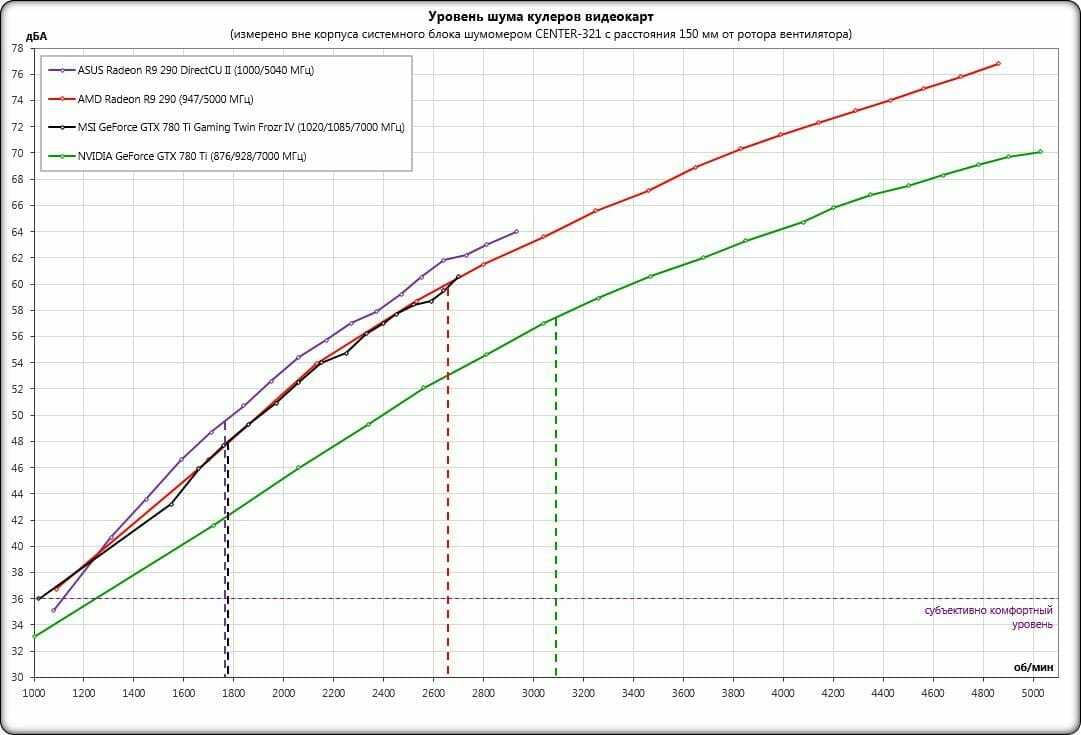
As you can see, the ASUS Radeon R9 290 DirectCU II is quieter than the reference card but only because its fans have lower speed when regulated automatically. Thanks to the efficient cooler design, the fans rotate at 1800 RPM, making the ASUS version much quieter than the reference R9 290. We wouldn’t call the ASUS comfortable in 3D applications, though. It is persistently audible against the background noise of a quiet computer. It is only in 2D applications when the GPU and graphics memory are clocked at 300 and 600 MHz that the card calms down. The fans with EBR bearings don’t produce any unwanted sound at any speed, at least when the graphics card is new. We can’t vouch for their behavior in a year, for example.
Внешний вид и система охлаждения
Видеокарта ASUS Radeon R9 290 OC с доработанной, как по дизайну, так и технически, системой охлаждения DirectCU II выглядит очень красиво, особенно с лицевой стороны. Придает солидности девайсу и внушительная масса графического ускорителя, основную часть которой составляет система охлаждения и металлическая пластина с обратной стороны текстолита. Общая длина графического ускорителя 287 мм.
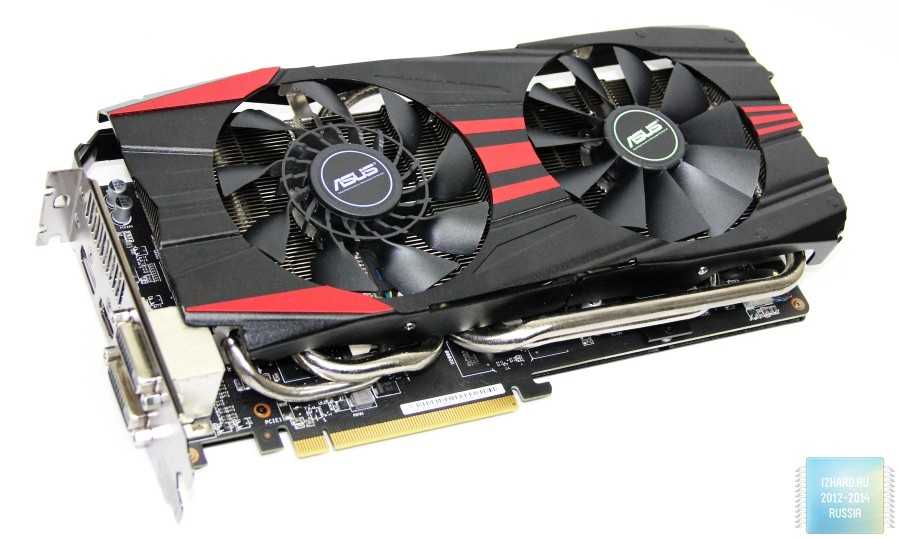
Сама по себе эта платина не охлаждает какие-либо элементы видеокарты, а служит для защиты платы от перегиба и перекручивания. С таким весом системы охлаждения такое инженерное решение вполне оправдано.
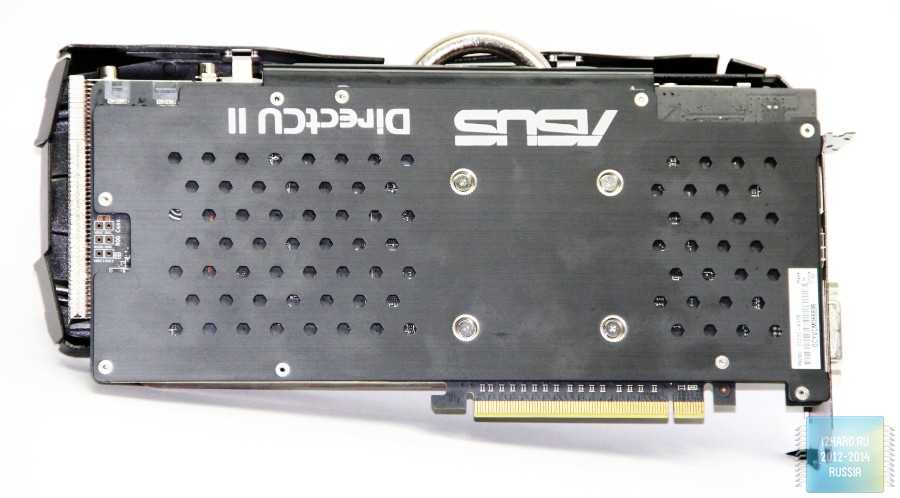
DirectCU II, установленная на видеокарту ASUS Radeon R9 290 OC, является системой охлаждения открытого типа. Использование тепловых трубок немного увеличило видеокарту в высоту.


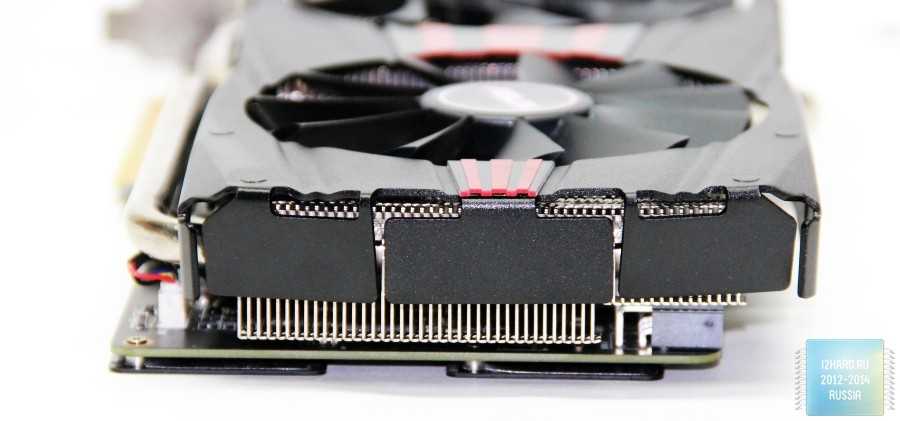
ASUS Radeon R9 290 OC для вывода изображения располагает двумя разъемами DVI-D, разъемом HDMI и DisplayPort.
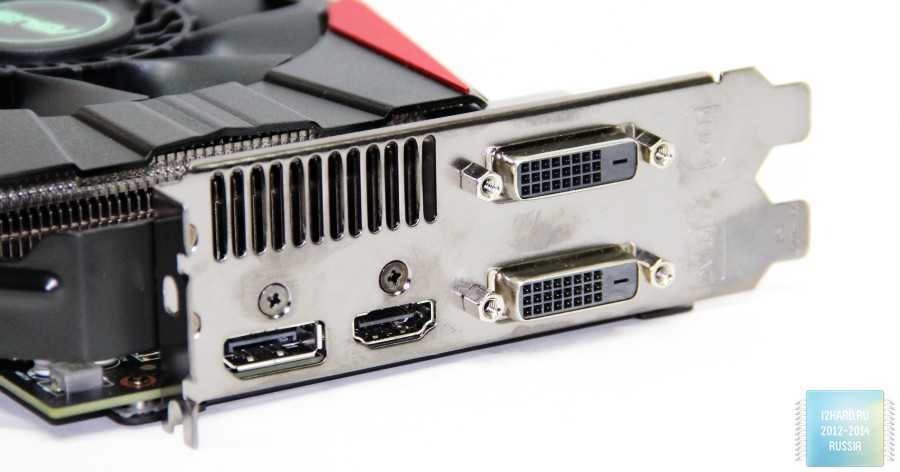
Несмотря на внушительные габариты печатной платы, навесные элементы на ASUS Radeon R9 290 OC расположены очень плотно. Таким плотным расположением элементов ASUS Radeon R9 290 OC обязана в первую очередь большими размерами графического процессора, большим количеством микросхем памяти, а также сложной системой питания.
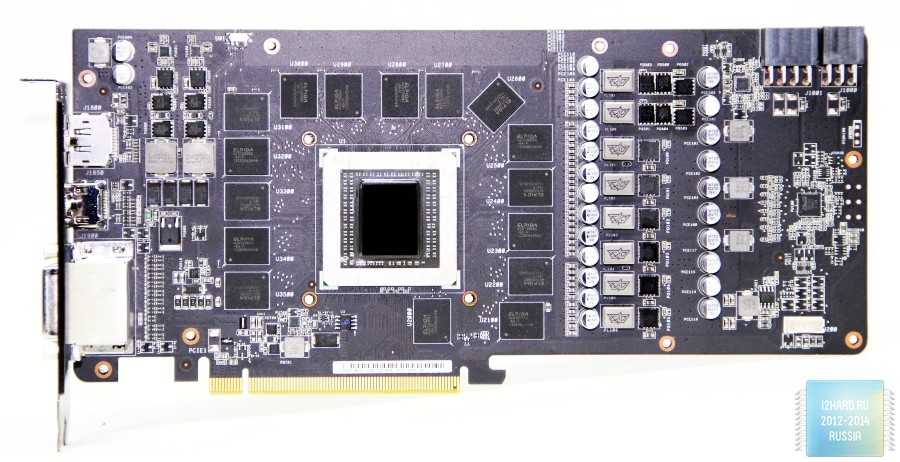
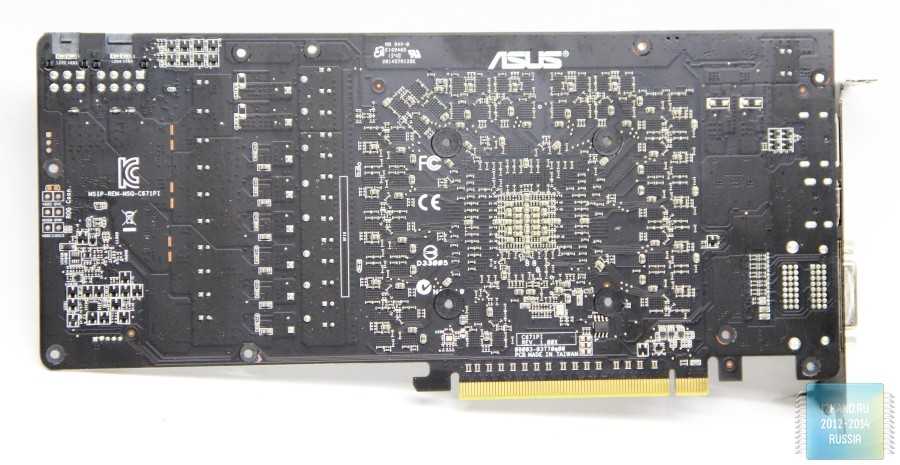
Защитная пластина, в тех местах, где она может соприкасаться с электрическими элементами платы, защищена слоем диэлектрической пленки.
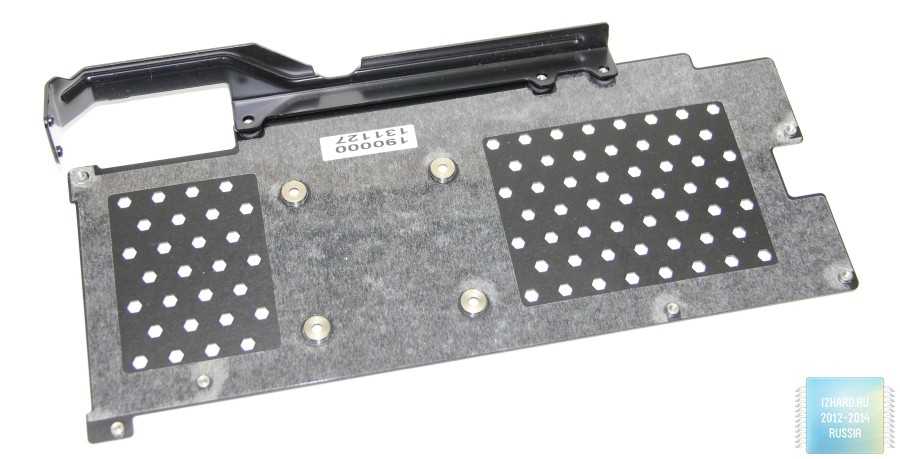
Переключатель BIOS расположен на верхней грани печатной платы. Разница между положениями переключателя проста — доступен либо производительный режим, либо тихий.
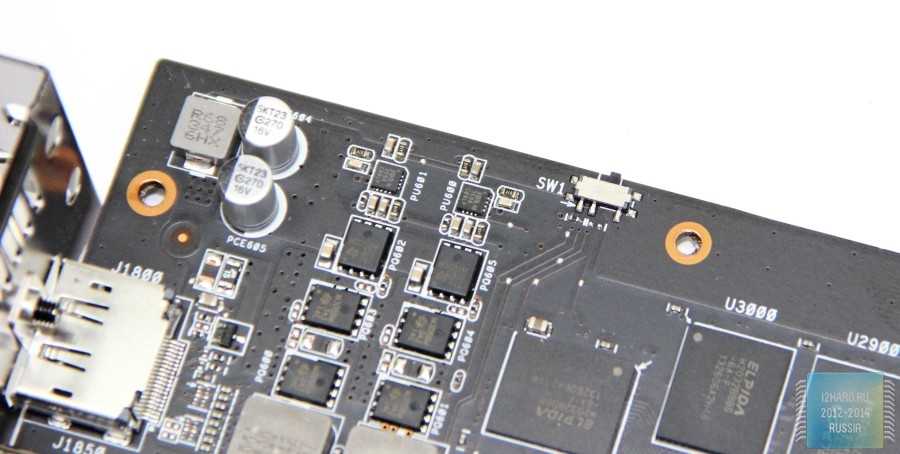
Отказ производителя разместить часть чипов памяти на тыльной стороне печатной платы внес свои коррективы в плотность их расположения на лицевой части. Микросхемы памяти вокруг AMD Hawaii расположены практически по кругу, а их монтаж выполнен очень плотно друг к другу.
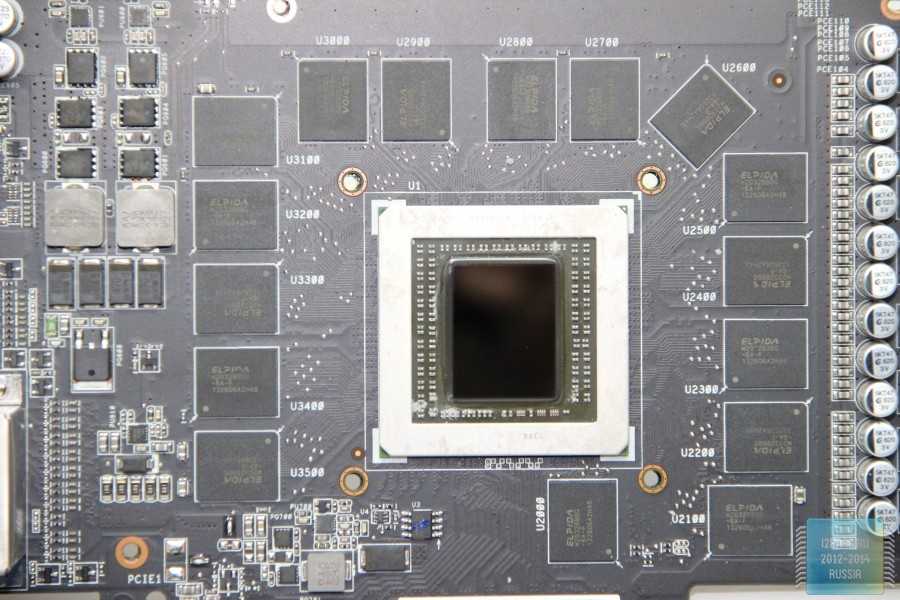
Графический процессор AMD Hawaii имеет очень большую площадь поверхности ядра и оснащен защитной металлической рамкой. 2560 универсальных потоковых процессора, заключенные в корпусе ядра, призваны обеспечить максимальную производительность этой видеокарты. Частота графического чипа AMD Hawaii у видеокарты ASUS Radeon R9 290 OC по сравнению с референсом немного увеличена, и составляет 1000МГц.
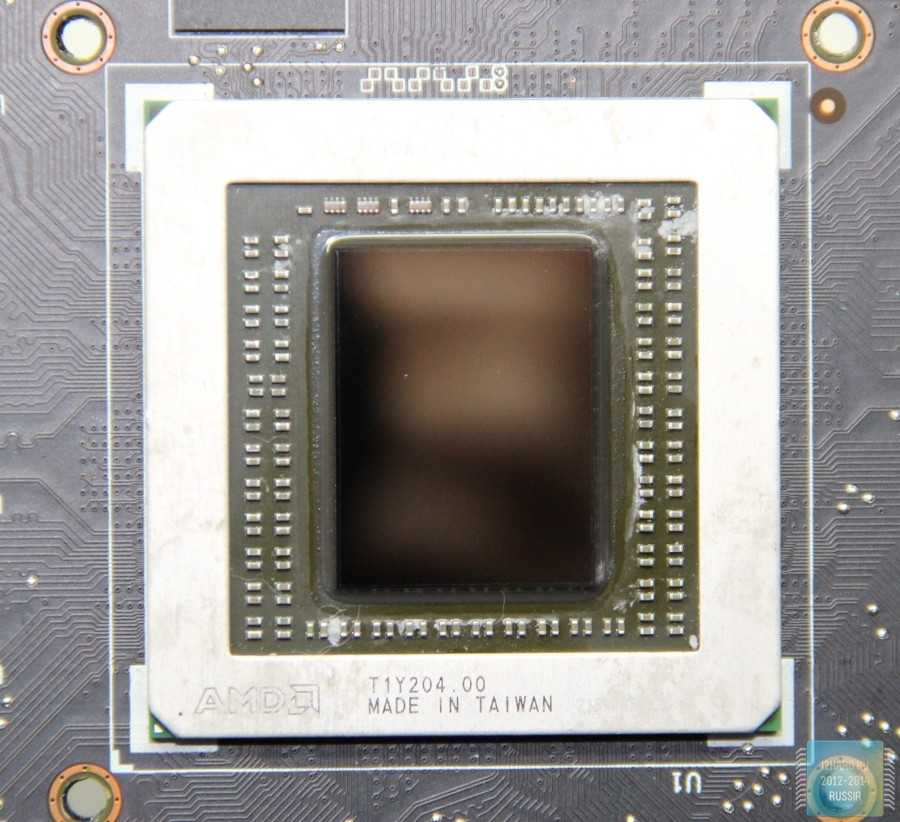
Микросхемы памяти используются производства компании Elpida с маркировкой W2032BBBG-6A-F. Объем памяти в 4Гб набран 16 микросхемами, шина памяти на ASUS Radeon R9 290 OC составляет внушительные 512Бит.

В ASUS Radeon R9 290 OC используется передовая система питания с цифровым управлением Digi+VRM. Схема питания работает по схеме 6+2+2, где 6 фаз отведены на питание GPU, и по две фазы питания на MEM и PLL.
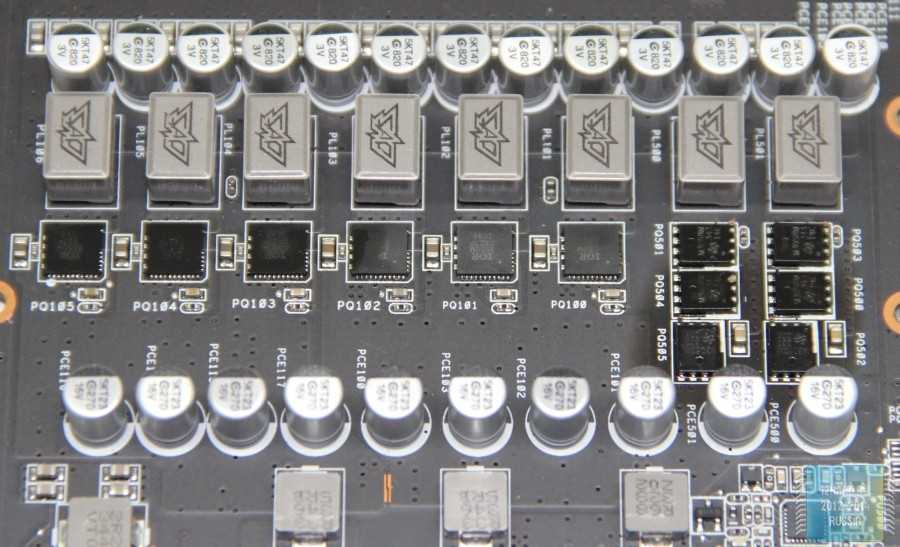
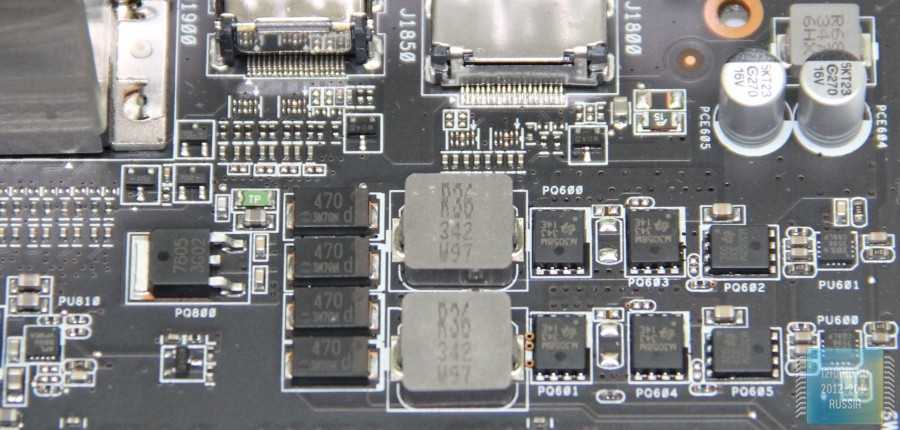
Наиболее нагреваемые силовые элементы охлаждаются алюминиевым радиатором, оснащенным термопрокладкой.
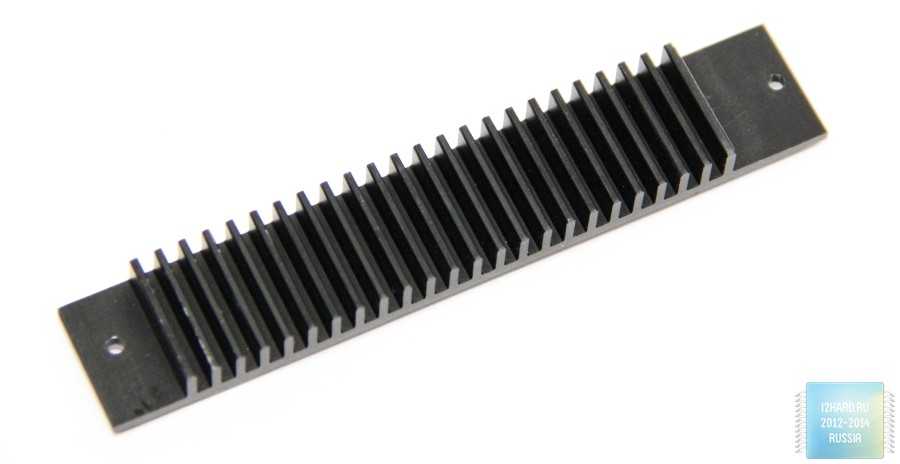
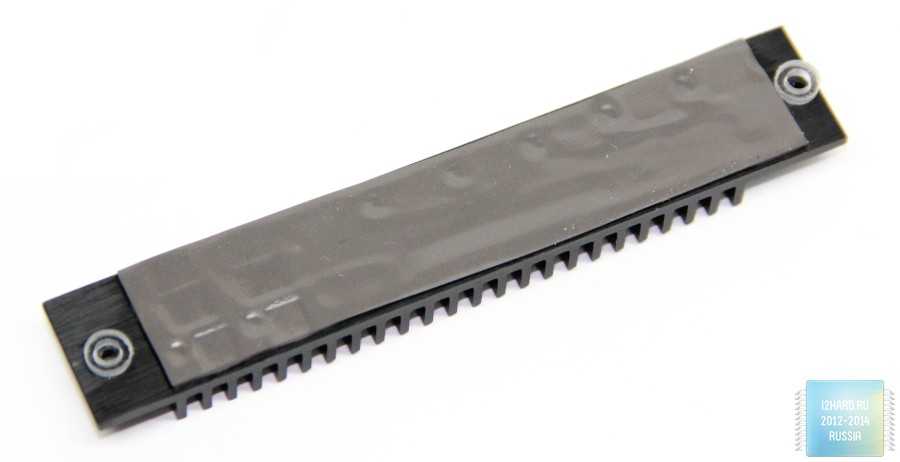
Управлением питания занимается ШИМ-контроллер Digi+VRM ASP1300.
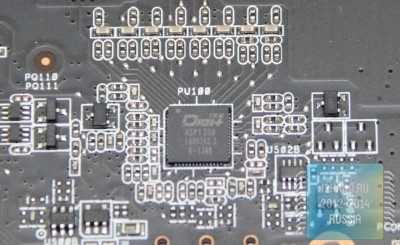
Для успешного запуска и эксплуатации видеокарты ASUS Radeon R9 290 OC требуется дополнительное питание, которое заводится в графический ускоритель с помощью комбинации двух разъемов 8+6pin.

Систему охлаждения DirectCU II, установленную на ASUS Radeon R9 290 OC, условно можно разделить на две составляющие. Это кожух системы охлаждения с двумя вентиляторами, и массивный алюминиевый радиатор с пятью тепловыми трубками.
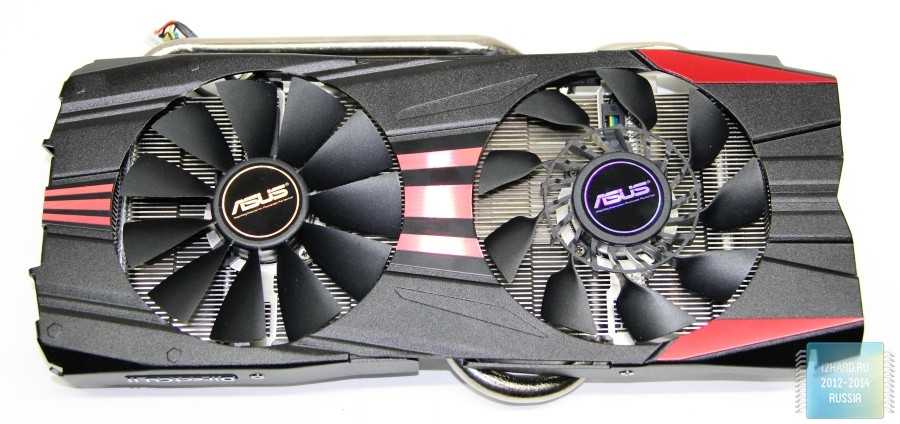
В ASUS Radeon R9 290 OC используется технология прямого контакта. По отпечатку графического ядра видно, что в теплопереносе задействованы только три трубки из пяти.
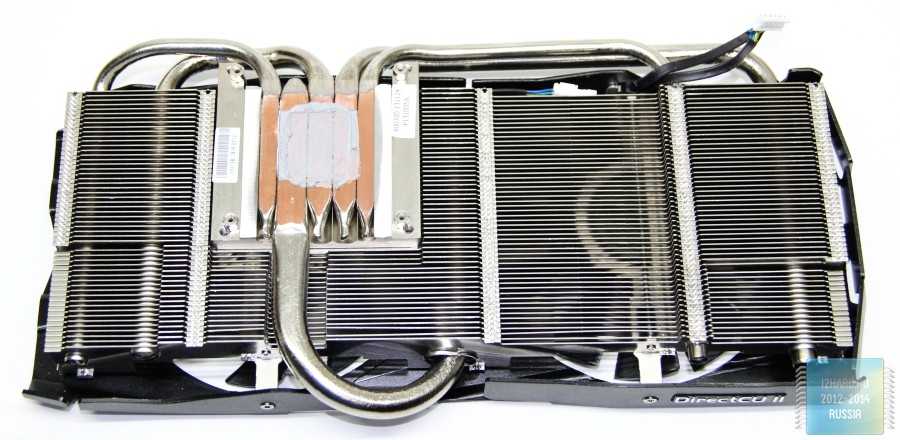
Металлический кожух СО ASUS Radeon R9 290 OC не несет на себе никаких элементов, охлаждающие радиатор вентиляторы закреплены на самом радиаторе системы охлаждения.
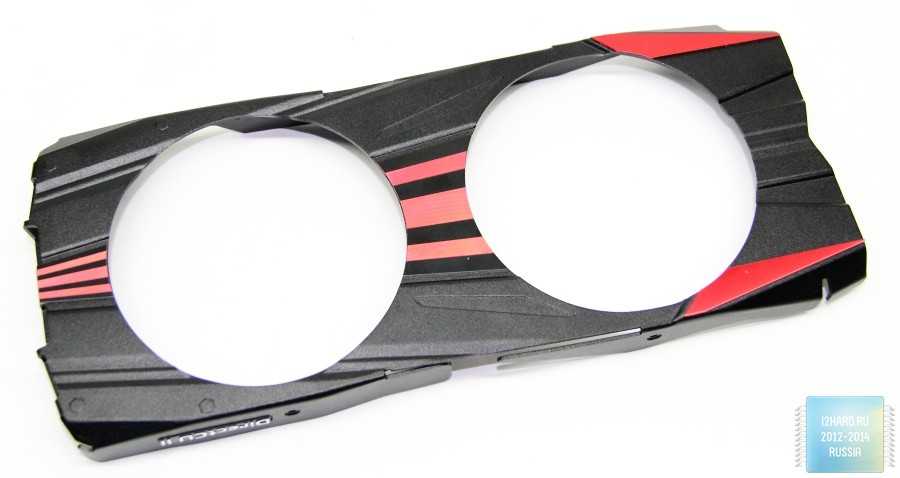
В охлаждении ASUS Radeon R9 290 OC используются два разных вентилятора фирмы Everflow, обычный — справа, и CoolTech-вентилятор слева. Наглядно увидеть аэродинамическую эффективность вентилятора, сделанного по CoolTech Fan технологии, можно по данной ссылке. https://www.youtube.com/watch?v=totFkHQftaI
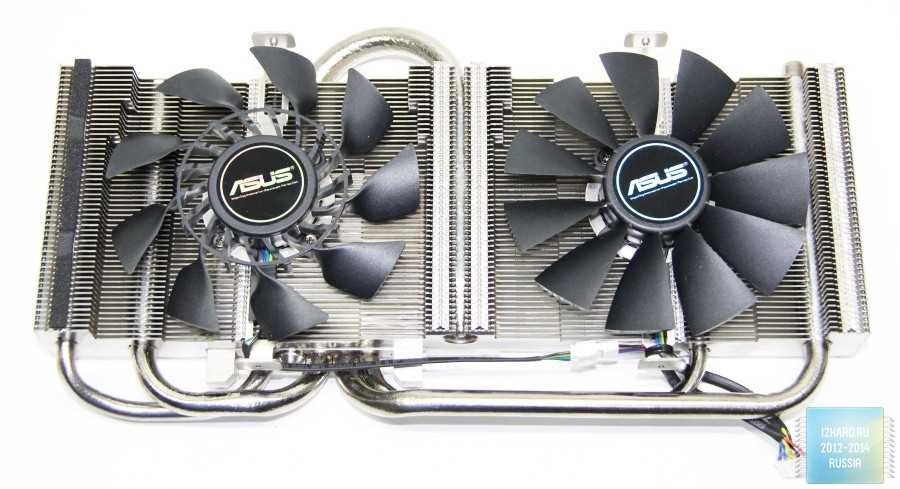
Сила тока обычного вентилятора составляет 0,5А, а рабочее напряжение 12В.
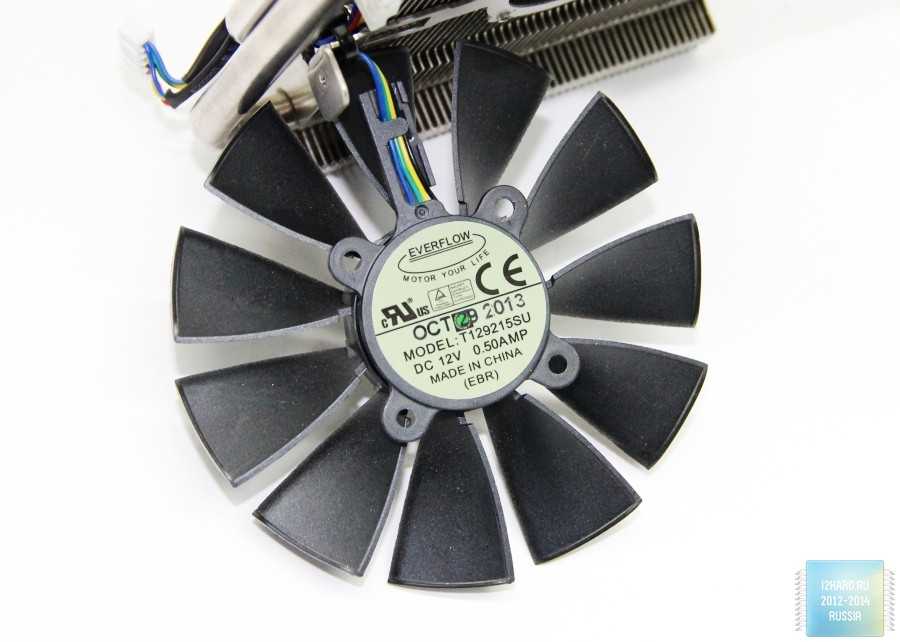
Такие же рабочие параметры и у вентилятора. крыльчатка которого сделана по CoolTech Fan технологии.
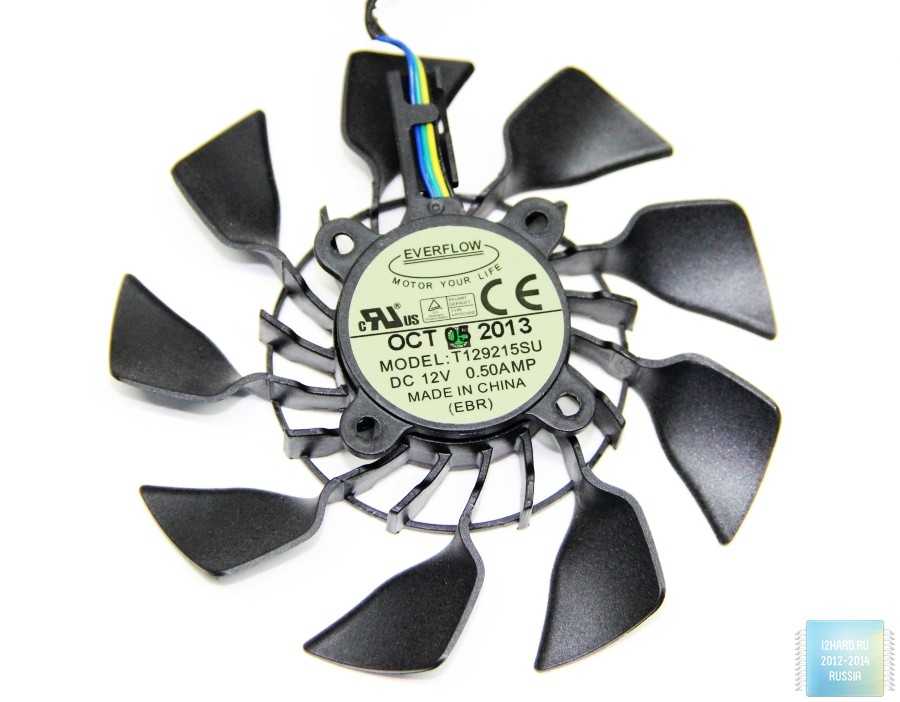
Технические характеристики
- Производитель: ASUS;
- Модель: ASUS Radeon R9 290 OC;
- Графический процессор: AMD Hawaii;
- Техпроцесс: 28 нм;
- Частота GPU: 1000 МГц;
- Кол-во шейдерных процессоров: 2560;
- Видеопамять: 4 Гб;
- Тип видеопамяти: GDDR5;
- Разрядность шины видеопамяти: 512 бит;
- Частота видеопамяти: 1260 МГц (5,04 ГГц QDR);
- Поддержка CrossFire: Есть;
- Поддержка HDCP: Есть;
- Поддержка API: DirectX 11.2, Mantle, OpenGL 4.x;
- Порты: DisplayPort, DVI-D, DVI-D, HDMI;
- Макс. кол-во подключаемых мониторов: 6;
- Разъем дополнительного питания: 8pin+6pin;
- Длина: 287 мм;
- Цена — 18000 рублей (средняя цена по данным Яндекс Маркет на момент обзора).
Performance Summary
In the first pair of summary charts we compare the original ASUS Radeon R9 290 DirectCU II (pre-overclocked to 1000/5040 MHz or by +5.6/1%) and the reference AMD Radeon R9 290 (947/5000 MHz), the latter serving as the baseline.
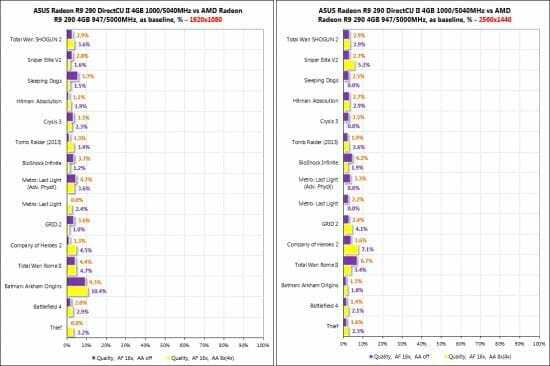
Despite the small difference in their clock rates, the ASUS is an average 3.1 to 3.2% faster at 1920×1080 and 2.4 to 2.8% faster at 2560×1440. The largest gap can be observed in Batman: Arkham Origins whereas in Metro: Last Light, Crysis 3, Hitman: Absolution and in some other games at the lower visual quality settings the two cards deliver similar performance. We guess the difference may be due to the ASUS’s efficient cooler. Thanks to it, the original card from ASUS never enables frequency throttling as the reference Radeon R9 290 may do.
The second pair of our charts helps compare the ASUS Radeon R9 290 DirectCU II with the reference AMD Radeon R9 290X, the latter serving as the baseline:
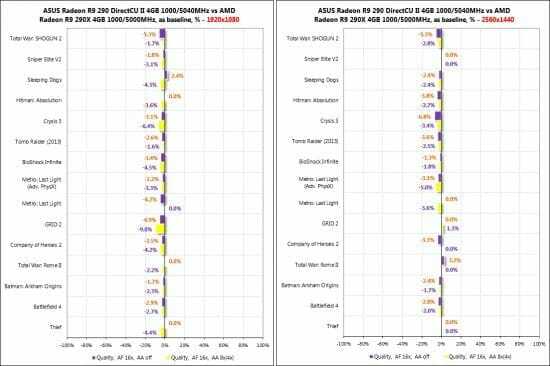
The gap is smaller than between the ASUS and the reference R9 290. The ASUS Radeon R9 290 DirectCU II is an average 2.1 to 3.6% slower at 1920×1080 and 1.8 to 2.1% slower at 2560×1440. The ASUS can be said to deliver the same speed as the reference Radeon R9 290X.
We also want to compare the ASUS with the original MSI GeForce GTX 780 Lightning:
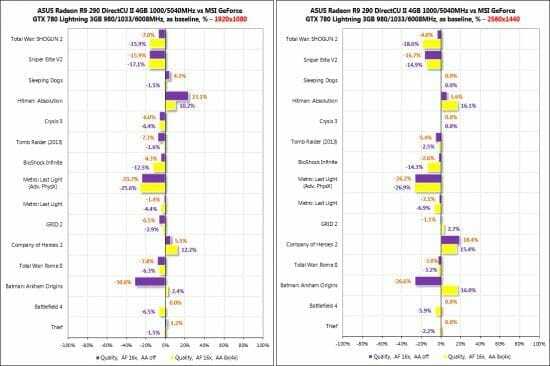
As opposed to the previous two pairs of summary diagrams, there is no clear winner here. The ASUS Radeon R9 290 DirectCU II is ahead in Hitman: Absolution, Company of Heroes 2 and Batman: Arkham Origins (with 8x MSAA). Meanwhile, the MSI GeForce GTX 780 Lightning is faster in Total War: SHOGUN 2, Sniper Elite V2, Crysis 3, Tomb Raider (2013), BioShock Infinite, Metro: Last Light (with Advanced PhysX), Total War: Rome II and Batman: Arkham Origins (without 8x MSAA). In the rest of the games these two graphics cards are close to each other, although the MSI enjoys an advantage of 3-5% on average across all of them.
PCB Design and Features
The Radeon R9 290 DirectCU II is easily identifiable as an ASUS product. Its face side is covered by the cooler’s stylish casing with two fans of different types. The metallic plate on the reverse side of the card serves to reinforce the PCB and protect its components but doesn’t play any role in dissipating their heat.
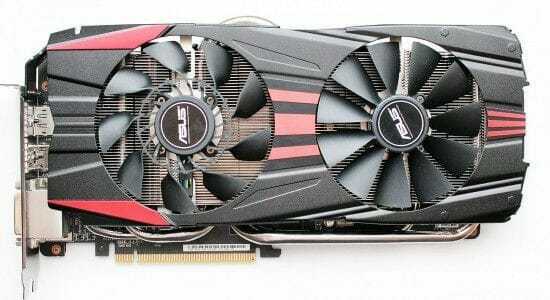
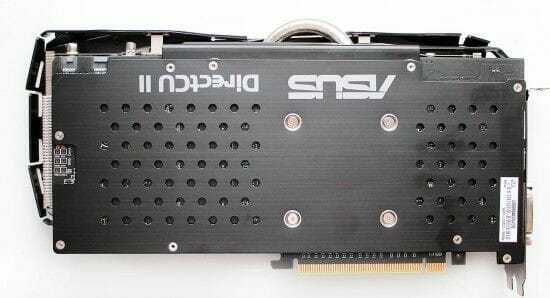

There’s a 10mm heat pipe sticking out of the heatsink. The card measures 281x137x41 millimeters, which is a mere 5 millimeters longer than the reference Radeon R9 290(X).
It offers dual-link DVI-I and DVI-D outputs, one HDMI 1.4a connector and a DisplayPort 1.2. There’s a vent grid in the card’s mounting bracket to exhaust the hot air out of the computer case.
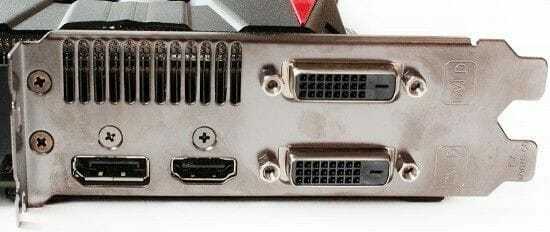
AMD’s Radeon R9 290 and 290X card have no CrossFireX connectors. As for power connectors, they are turned around on the ASUS card and feature LED highlighting:
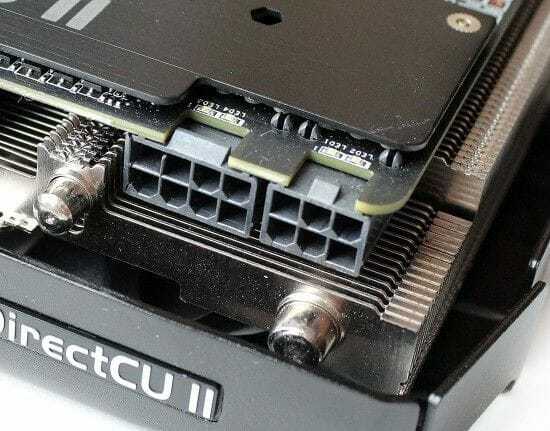
The ASUS Radeon R9 290 DirectCU II is specified to consume up to 300 watts, which is 25 watts more than the reference card needs.
Although massive, the cooling system is only secured with four screws around the GPU, so it is very easy to take off:
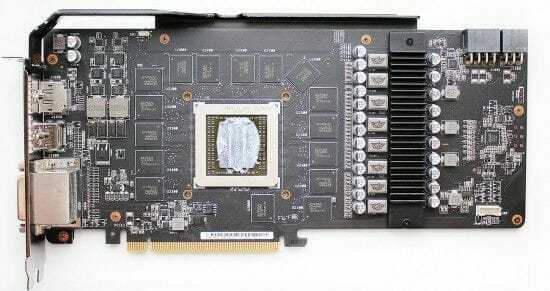
After unfastening a few more elements, such as a top stiffening rib and a small aluminum heatsink on the power system components, we can take a closer look at the PCB:
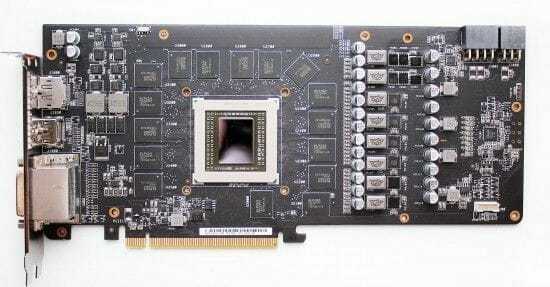
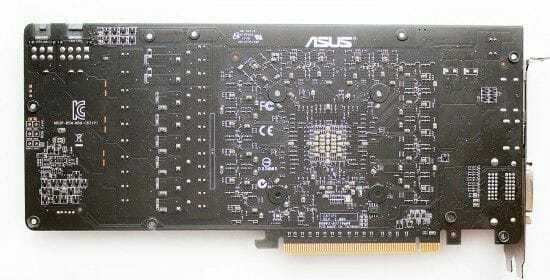
The custom-design PCB features ASUS’s Super Alloy Power technology and a 10-phase power system (with 6 phases for the GPU, 2 for memory chips and 2 for PLL).
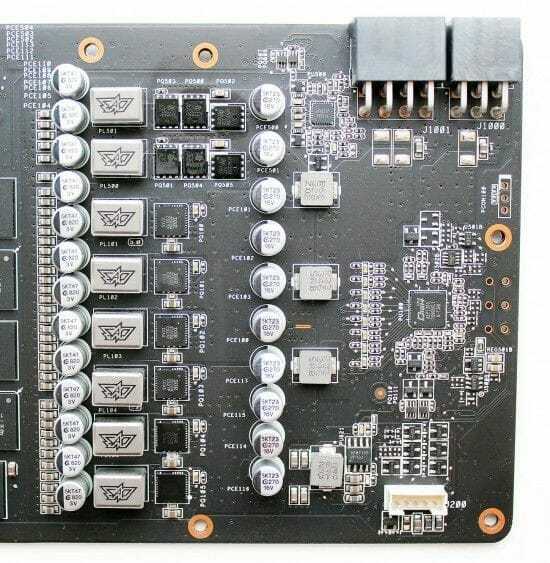
Like all other ASUS products of this class (including GeForce-based ones), the card employs Japan-made solid-state tantalum capacitors, DrMOS transistors and ferrite-core chokes.

The premium components are supposed to substantially improve the product’s efficiency, stability and service life. The small BIOS switch you can see in the photo selects one of two operation modes: Silent or Performance. They define the regulation algorithm of the cooler’s fans.
The GPU voltage regulator is based on an ASP1300 controller.
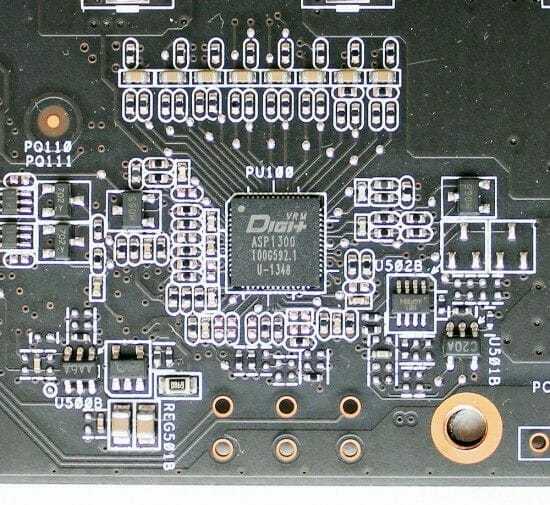
Unfortunately, we couldn’t find any information about it.
There are ROG Connector check points on the PCB for measuring voltages.
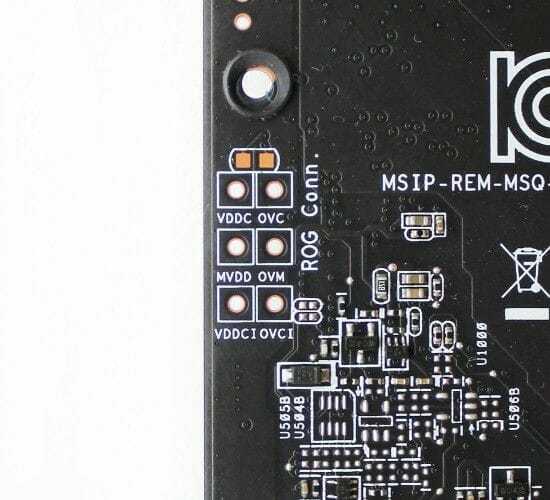
Judging by the marking, the GPU of our sample of the card was manufactured in Taiwan on the 44th week of 2013:
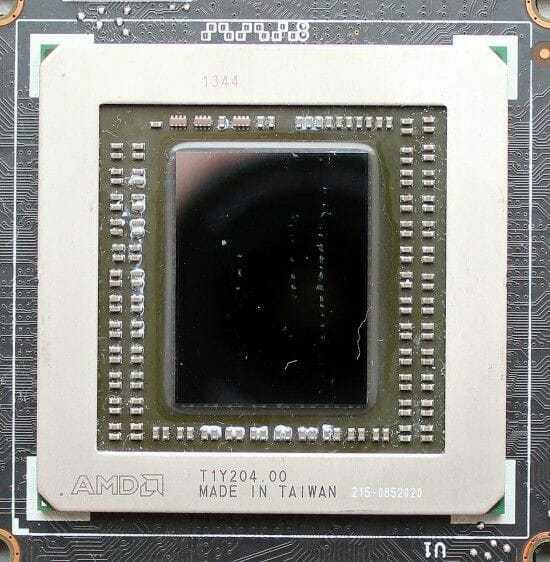
The GPU is clocked at 1000 MHz in 3D applications, which is 53 MHz (or 5.6%) higher compared to the reference Radeon R9 290. That’s not the best factory overclocking we’ve seen as some manufacturers pre-overclock their R9 290 to 1040 MHz. In 2D applications the ASUS card drops its GPU clock rate to 300 MHz and lowers its voltage. The ASIC quality of our GPU chip is 68.4%:
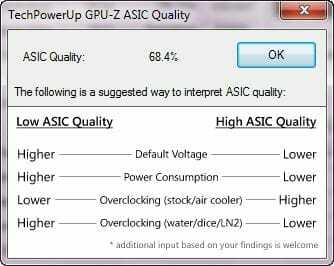
The graphics card comes with 4 gigabytes of GDDR5 memory in Elpida’s W2032BBBG-6A-F chips.
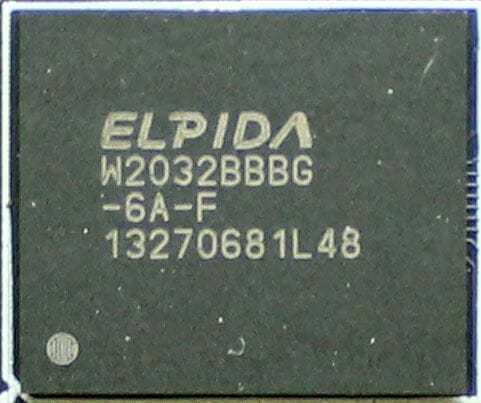
The chips are rated for 6000 MHz but the reference Radeon R9 290 and R9 290X have a memory frequency of 5000 MHz. ASUS increases it to 5040 MHz, which can hardly be even called overclocking. The peak memory bandwidth is 322.6 GB/s.
The GPU-Z screenshot below summarizes the ASUS Radeon R9 290 DirectCU II specs:
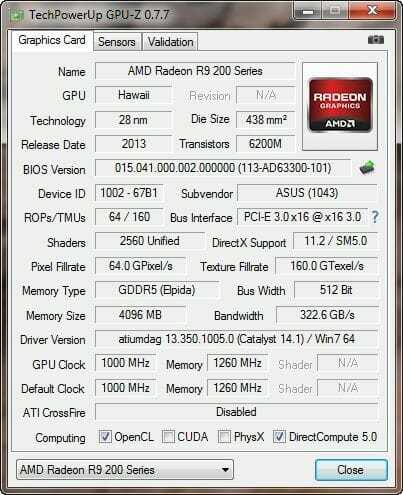
Now we can proceed to testing its cooler.
Power Consumption
We measured the power consumption of computer systems with different graphics cards using a multifunctional panel Zalman ZM-MFC3 which can report how much power a computer (the monitor not included) draws from a wall socket. There were two test modes: 2D (editing documents in Microsoft Word and web surfing) and 3D (the intro scene of the Swamp level from Crysis 3 running four times in a loop at 2560×1440 with maximum visual quality settings but without MSAA). Here are the results:
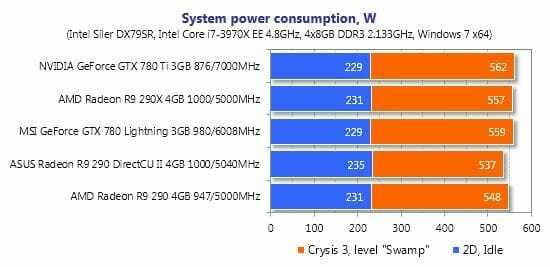
Interestingly, all of the tested configurations are comparable in terms of their 3D power draw. The ASUS Radeon R9 290 DirectCU II is somewhat more economical than the others, yet not by much. Each configuration can be powered by a high-quality 600W PSU.
Performance
The results of the ASUS Radeon R9 290 DirectCU II are colored lilac. The color of the Nvidia GeForce GTX 780 Ti and MSI GeForce GTX 780 Lightning is light green whereas the color of the Radeon R9 290X and R9 290 is AMD’s traditional red. The cards are listed in the order of descending retail price.
3DMark (2013)
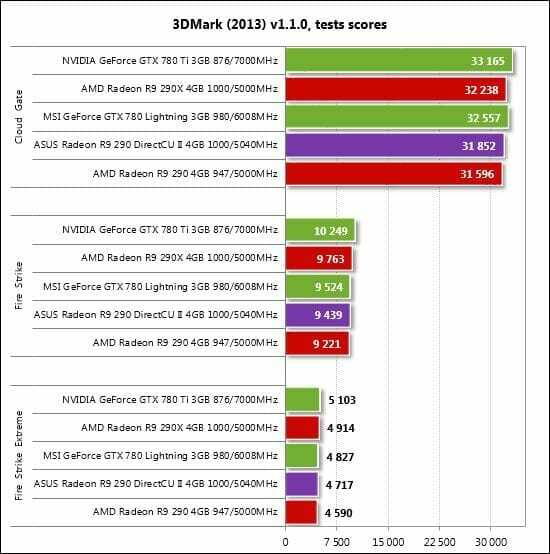
The five graphics cards have close results in this synthetic benchmark, the difference between the fastest (GeForce GTX 780 Ti) and the slowest (Radeon R9 290) being a mere 11.2% in the heaviest scene (Fire Strike Extreme). The ASUS Radeon R9 290 DirectCU II is a mere 2.8% faster than the reference R9 290 and 4% slower than the Radeon R9 290X. Such a small difference can hardly be noticed while playing.
Unigine Valley Bench
We’ve got a different picture in Unigine Valley:
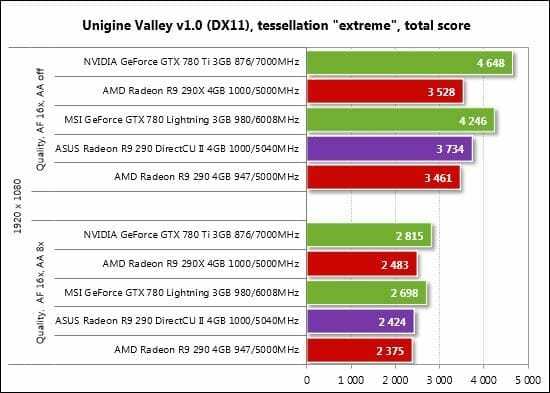
The Nvidia-based products are superior to their AMD-based opponents. Interestingly, the ASUS Radeon R9 290 DirectCU II is a little faster than the more advanced R9 290X at the AA-less settings. Of course, it beats the reference R9 290, too.
Total War: SHOGUN 2 – Fall of the Samurai
The Nvidia-based cards are also superior in the first game on our test program:
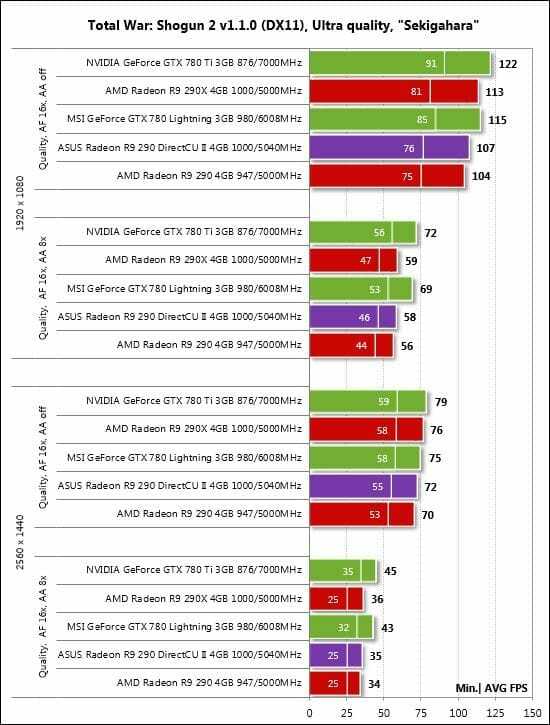
They are especially good with enabled antialiasing, which is what such top-end cards are actually bought for. The ASUS is 3 to 4% ahead of the reference AMD Radeon R9 290 and 2 to 5% slower than the Radeon R9 290X.
The GeForce GTX cards win this test, too.
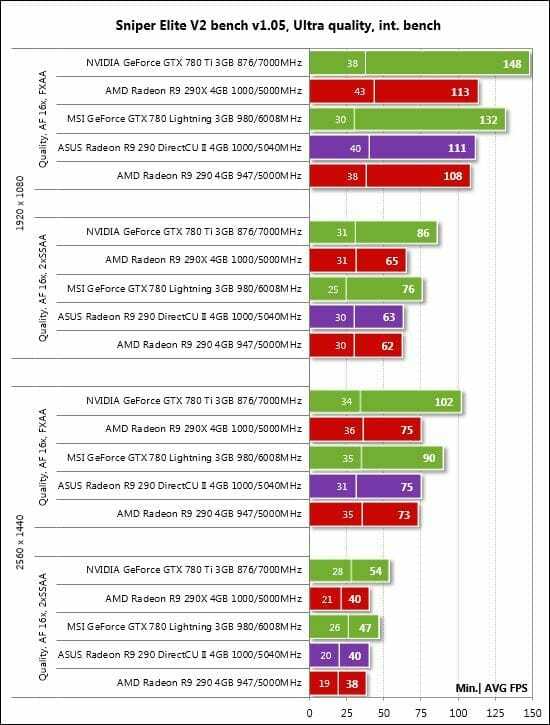
The three Radeon R9 series products have very close results here.
Sleeping Dogs
All of the tested cards have similar results in this game irrespective of the visual quality settings:
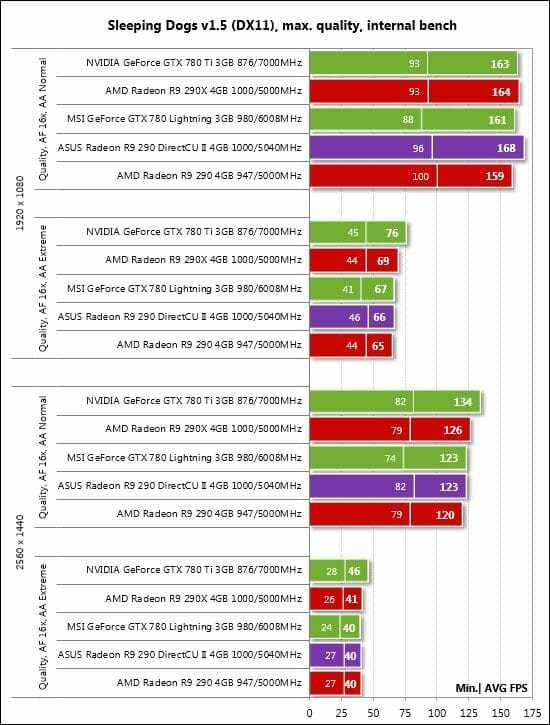
The reference GeForce GTX 780 Ti is a little ahead of the others with the exception of the easiest settings. The remaining four cards differ by less than 4%.
Hitman: Absolution
AMD-based solutions have always been superior to their opponents in Hitman: Absolution.
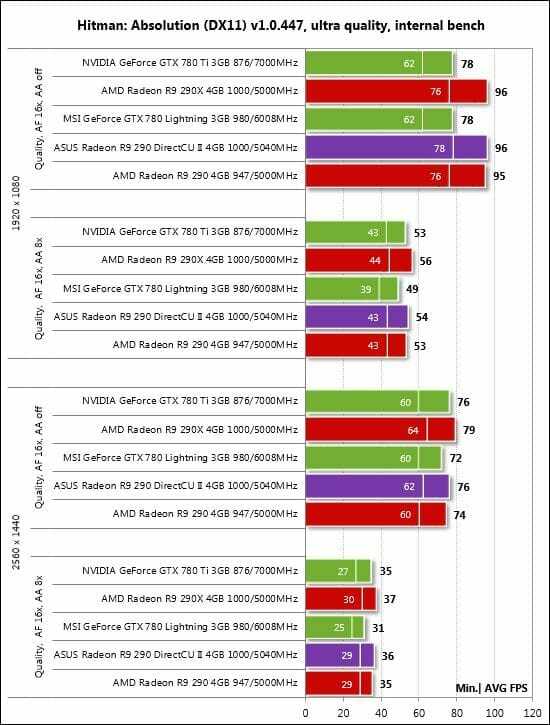
The ASUS Radeon R9 290 DirectCU II is 6 to 23% ahead of the MSI GeForce GTX 780 Lightning, following close behind the Radeon R9 290X.
Crysis 3
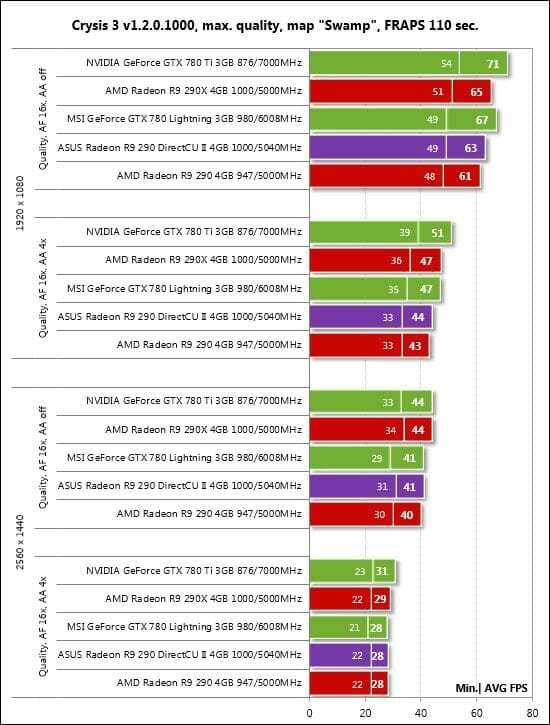
When it comes to Crysis 3, the cards differ less at 2560×1440 with 4x MSAA than at the lower settings. The ASUS is 2-3% faster than the reference Radeon R9 290 and 3-7% slower than the Radeon R9 290X.
We’ve got the same picture as in the previous game:
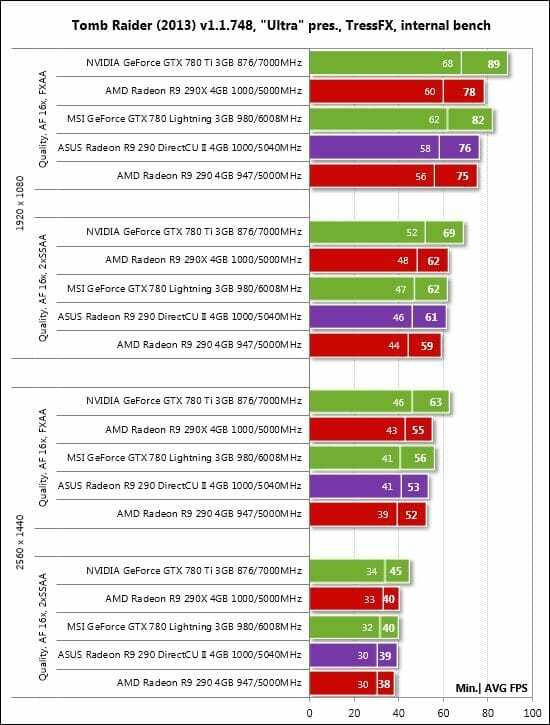
BioShock Infinite
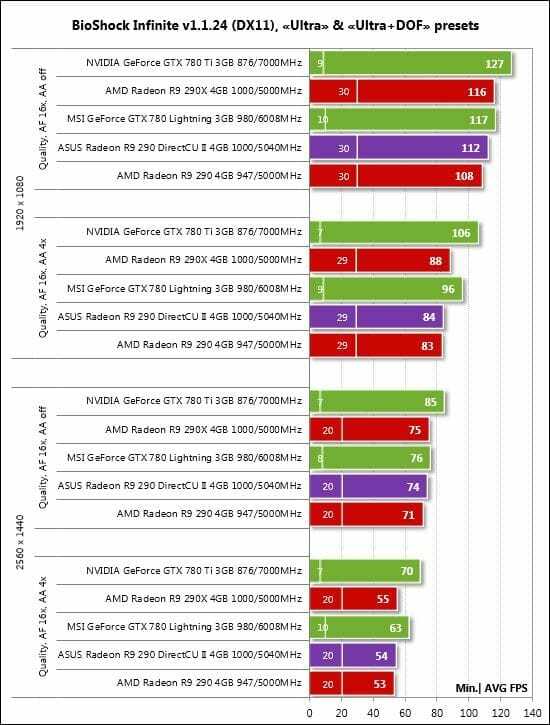
The Nvidia-based cards are better in terms of average frame rate but have a much lower bottom speed. BioShock Infinite players report that the game runs smoothly on both Nvidia and AMD-based products, so the occasional bottoming-out of the frame rate must be a peculiarity of the benchmark. We can also note that there’s very little difference between the AMD-based cards here.
Metro: Last Light
First we run this game with Advanced PhysX turned on:
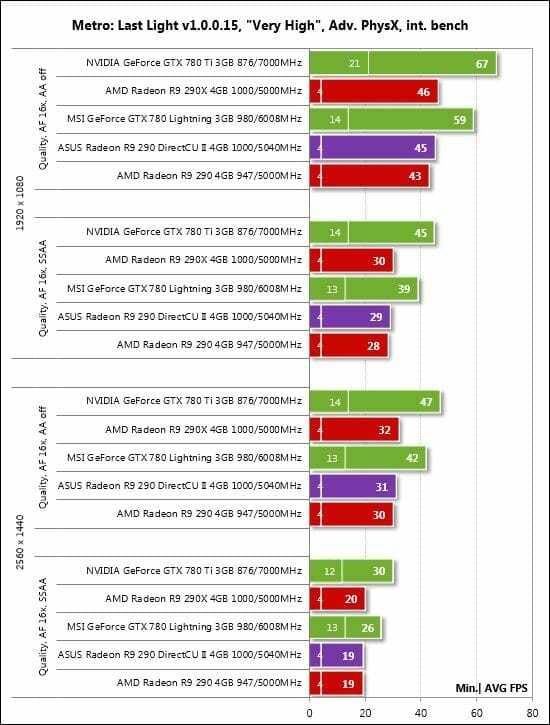
There’s no need to comment here as the results are obvious. When the additional physics effects are turned off, the Radeon R9 290(X) cards become more competitive:
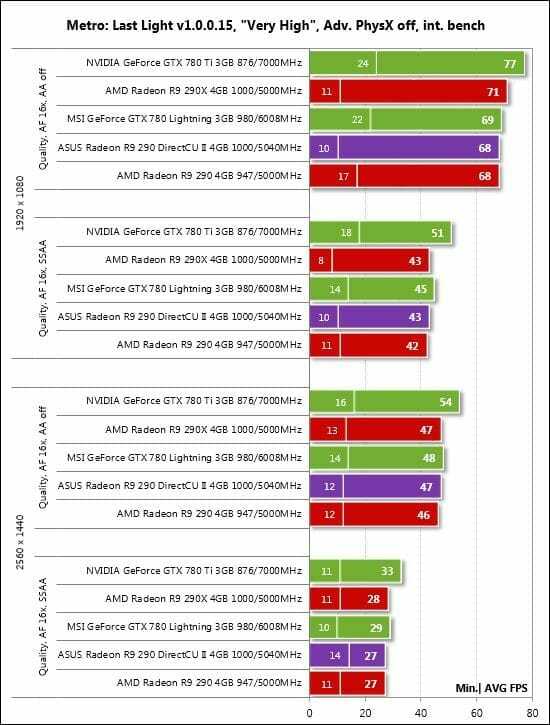
There’s almost no difference between the reference AMD cards and the original ASUS.
GRID 2
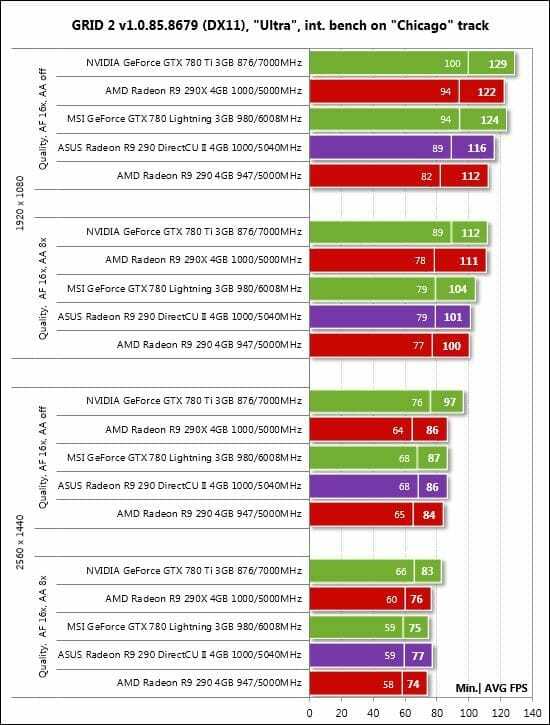
Here’s one more game where the cards have close results at the higher visual quality settings. The only exception is the GeForce GTX 780.
Company of Heroes 2
This game is won by the AMD-based cards.
The ASUS Radeon R9 290 DirectCU II is a little faster than the reference AMD Radeon R9 290 and a little slower than the Radeon R9 290X.
Total War: Rome II
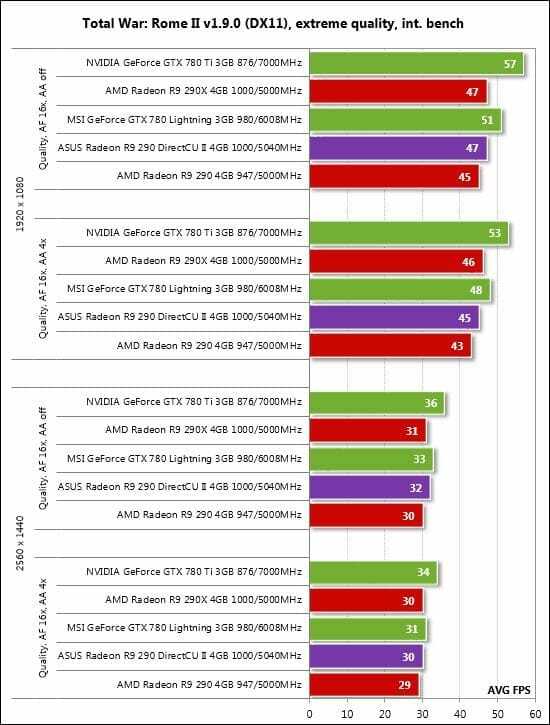
The GeForce series cards are ahead of their Radeon opponents in this game, but the gap is small, especially at 2560×1440. The three Radeons have almost identical results here.
Batman: Arkham Origins
The Nvidia-based cards are unrivalled in this game when antialiasing is turned off. With 8x MSAA enabled, AMD triumphs:
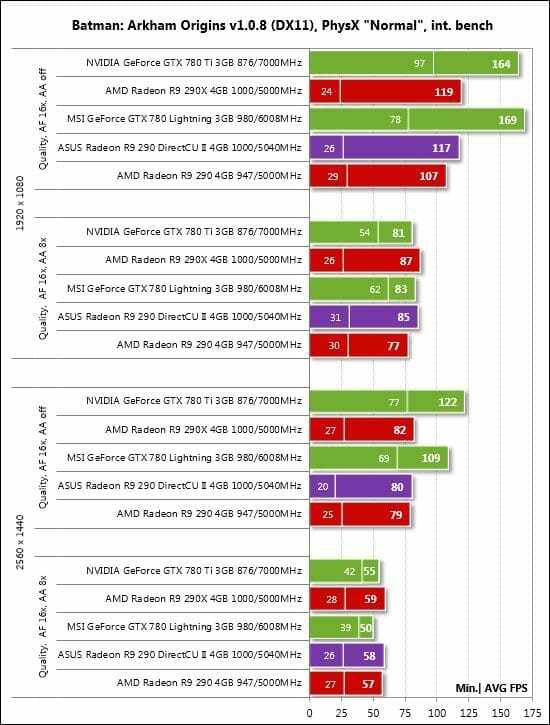
The three Radeons deliver the same performance.
Battlefield 4
It’s not easy to choose the best graphics card for playing Battlefield 4 because the five tested products deliver the same performance and we didn’t use the Mantle API which doesn’t work well with the latest Catalyst.
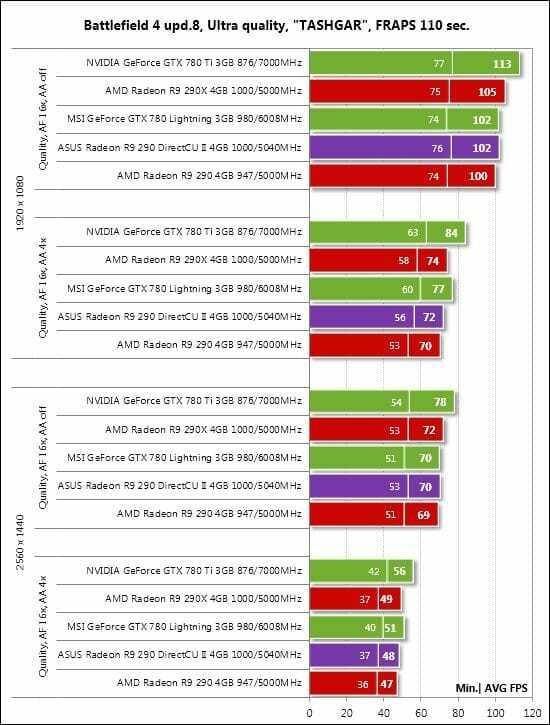
The cards are comparable to each other, the three Radeons having almost identical results.
Thief
It’s the first time we use the recently released Thief for our tests, so here are the graphics quality settings we enable in it:
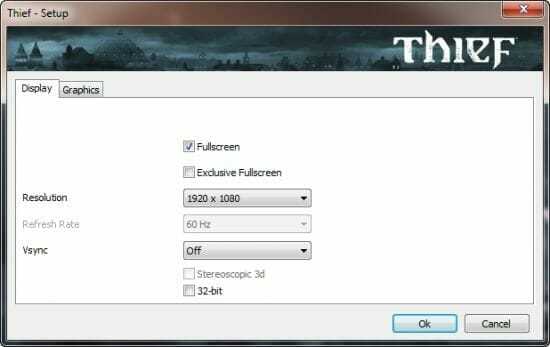
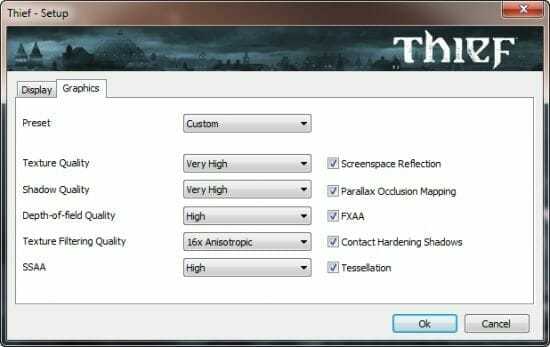
So the settings are all at their maximums to put high load on the graphics subsystem. The resolution and SSAA level were varied depending on the test mode. Here are the results:
The reference GeForce GTX 780 Ti wins this test but is closely followed by the AMD Radeon R9 290X. Then we see the MSI GeForce GTX 780 Lightning and ASUS Radeon R9 290 DirectCU II which have similar results. The AMD Radeon R9 290 takes last place, but isn’t really much slower. We can note that the AMD-based products have a higher bottom speed than their Nvidia-based rivals, which is important for smooth gameplay.
Here is a table with the full test results:
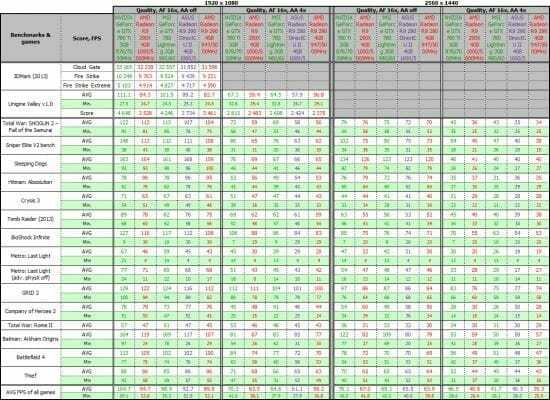
Now we can move on to our performance summary charts.
Learn more about the ASUS R9290X-DC2OC-4GD5
| Brand | ASUS |
|---|---|
| Model | R9290X-DC2OC-4GD5 |
| Interface | PCI Express 3.0 |
|---|
| Chipset Manufacturer | AMD |
|---|---|
| GPU | Radeon R9 290X |
| Core Clock | 1050 MHz |
| Effective Memory Clock | 5400MHz |
|---|---|
| Memory Size | 4GB |
| Memory Interface | 512-Bit |
| Memory Type | GDDR5 |
| DirectX | DirectX 11.2 |
|---|---|
| OpenGL | OpenGL 4.4 |
| HDMI | 1 x HDMI |
|---|---|
| DisplayPort | 1 x DisplayPort |
| DVI | 2 x DVI-D |
| Max Resolution | Digital: 4096 x 2160 |
|---|---|
| Eyefinity Support | Yes |
| CrossFireX Support | Yes |
| Cooler | With Fan |
| HDCP Ready | Yes |
| Features | DirectCU II achieves 20% lower temps with 220% the dissipation area, plus 3X quieter running than reference.Exclusive CoolTech Fan drives wider airflow to keep critical components cool.1050 MHZ engine clock for better performance and outstanding gaming experience.DIGI+ VRM with 8-phase Super Alloy Power delivers precise digital power for superior efficiency, reliability, and performance.GPU Tweak helps you modify clock speeds, voltages, fan performance and more, all via an intuitive interfac.GPU Tweak Streaming let you share on-screen action in real time — so others can watch live as games are played.4.7% faster game performance than reference Radeon R9 290X in Metro Last Light. |
|---|
| Card Dimensions (L x H) | 11.3″ x 5.8″ |
|---|
Разгон
Несмотря на заводской разгон, видеокарту можно дополнительно форсировать. После незначительного повышения напряжения питания (25 мВ) частоту графического процессора удалось увеличить до 1115 МГц. Если сравнивать с базовыми 947 МГц для референсных моделей, то разница составляет внушительные 17,7%.
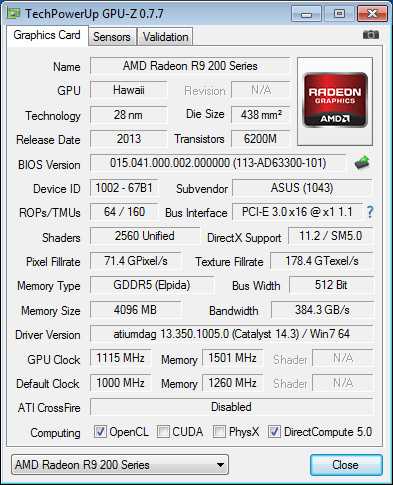
Тактовая частота памяти в процессе экспериментов была увеличена до 6008 МГц (1502 МГц), то есть на 19,2%. Учитывая 512-битовую шину, пропускная способность магистрали между графическим процессором и локальной ОЗУ возросла в этом случае до 384,3 ГБ/c.
После дополнительного разгона пиковый нагрев GPU увеличился до 80С. Даже после дополнительного форсирования запаса прочности системы охлаждения достаточно для того, чтобы даже в условиях критических нагрузок частота графического процессора не снижалась, обеспечивая максимально возможную производительность.
Упаковка и комплектация
Являясь представителем числа высокопроизводительных решений, видеокарта ASUS Radeon R9 290 OC поставляется в коробке исполинских размеров. Повышенные частоты, набортная память 4Гб, цифровое управление питанием DIGI+ VRM и программное обеспечение GPU Tweak — это далеко не полный список основных технических особенностей видеокарты, которые производитель разместил на упаковке своего продукта.
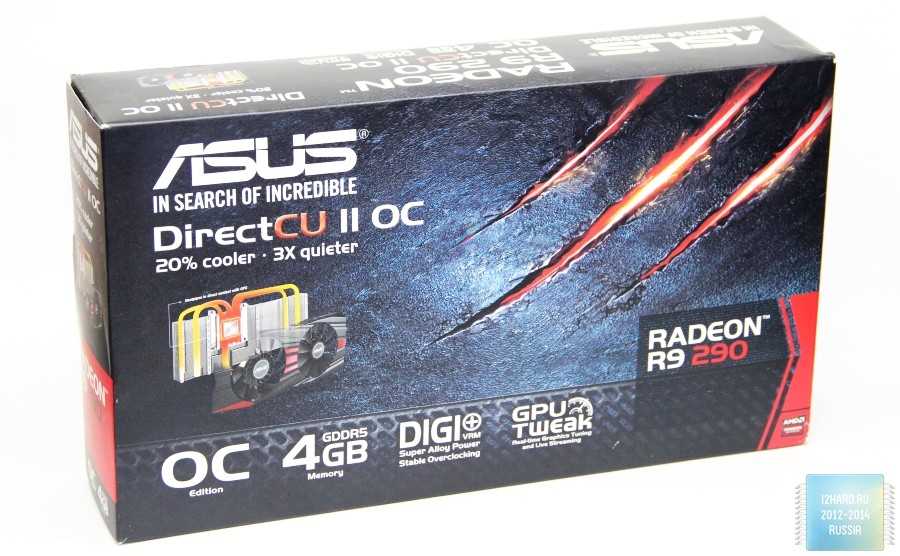
Отдельно от прочих особенностей видеокарты ASUS Radeon R9 290 OC выделено использование фирменного охлаждения DirectCU II, которое является собственной инженерной разработкой компании.
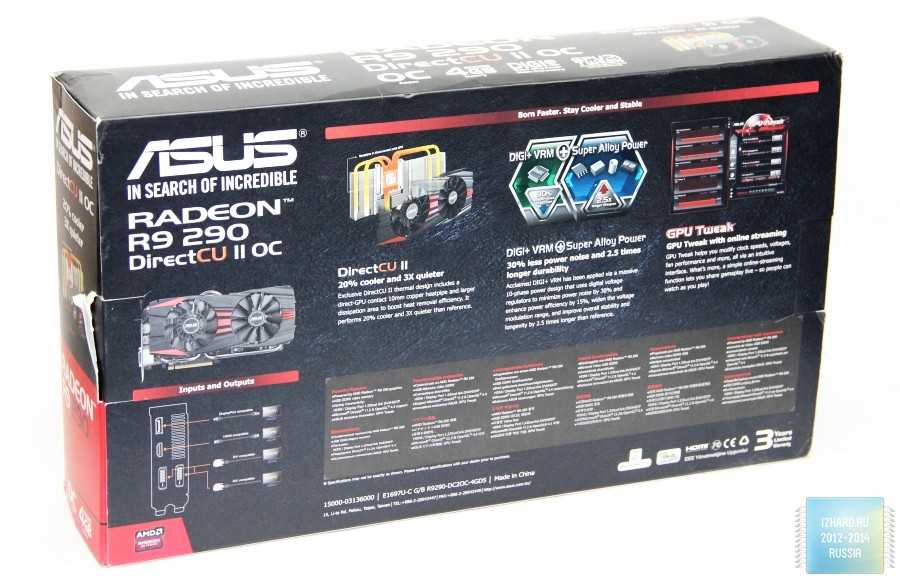
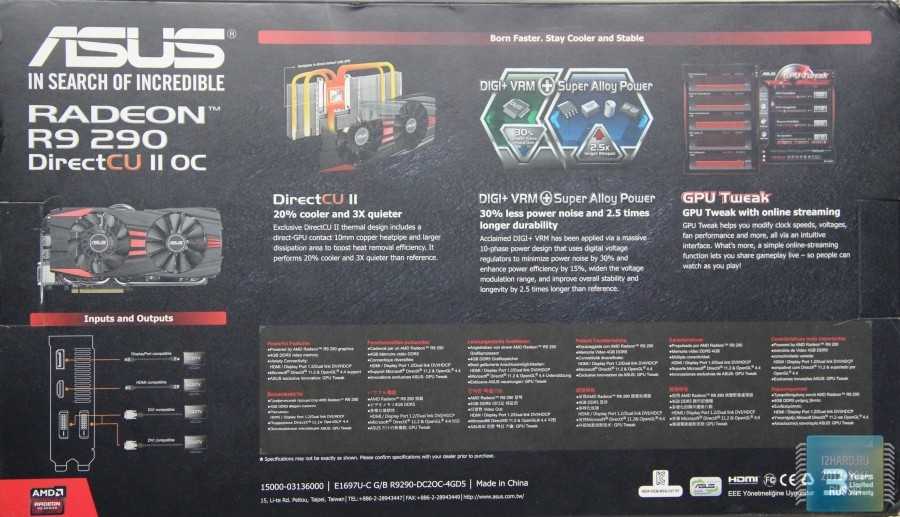
Упаковка ASUS Radeon R9 290 OC не внушает опасений, видеокарта упакована в черный картонный короб, внутри которого видеокарта находится в специальном отсеке из плотного поролона.
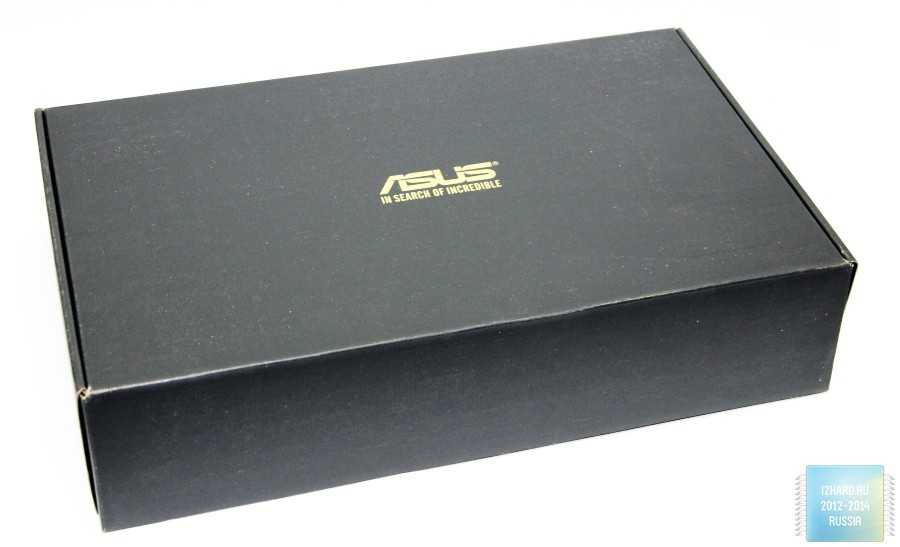
Комплект поставки ASUS Radeon R9 290 OC, попавшей к нам на тестирование, состоит из:
- видеокарта ASUS Radeon R9 290 OC (R9290-DC2OC-4GD5);
- переходник питания 2*6pin > 1*8pin;
- руководство пользователя;
- CD с драйверами.
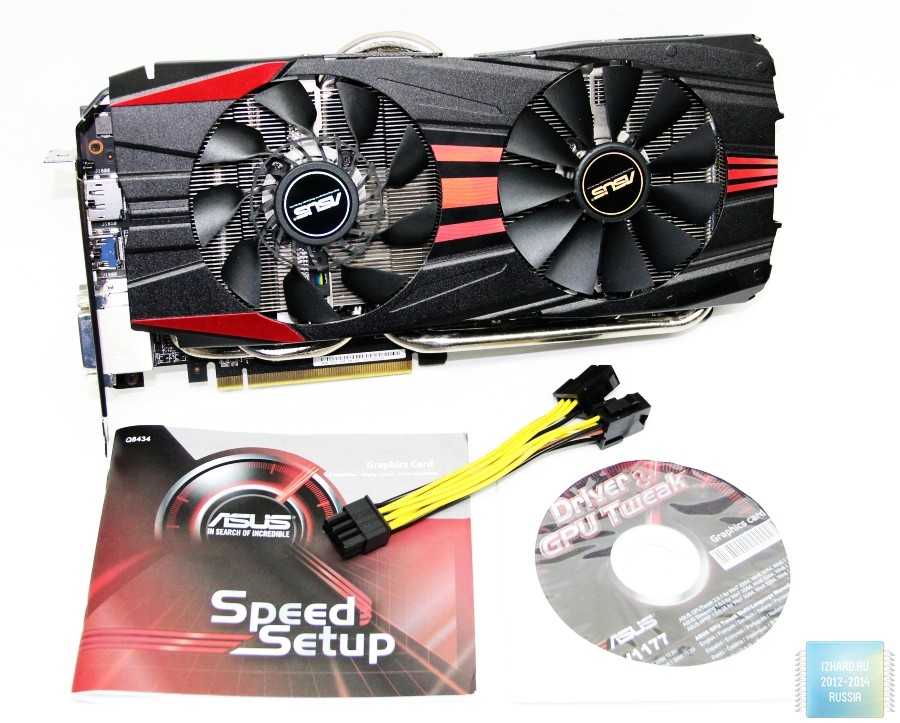
Выводы
Компании ASUS в очередной раз удалось продемонстрировать свое умение делать из обыденных продуктов интересные и свежие решения. Перед нами видеокарта с добротной компонентной базой и безумным количеством полезных фишек для оверклокеров и энтузиастов. Но все это было бессмысленно, если бы устройство не обладало хорошим разгонным потенциалом. Отдельно стоит отметить стильный дизайн. Благодаря своему визуальному оформлению ROG MATRIX R9 290X PLATINUM наверняка станет в будущем изюминкой многих моддинг-проектов.
К недостаткам можно причислить бедную комплектацию. Все-таки, если речь идет о решении в рамках серии Republic of Gamers, то производитель мог позаботиться о чем-то «игровом» в наборе с платой.
Нельзя не отметить напоследок: ASUS ROG MATRIX R9 290X PLATINUM — действительно дорогое удовольствие. За все нестандартное и инновационное приходится хорошо платить. И если вы не собираетесь ставить рекорды, лить ручьем жидкий азот без меры, то стоит присмотреть модель поскромнее. У той же ASUS их предостаточно.

























